
Remembering

lights back on
Getting your
A day in the life of a lineman
Aliceville POW Camp


Central Alabama Electric Cooperative 103 Jesse Samuel Hunt Blvd. Prattville, AL 36066 www.caec.coop
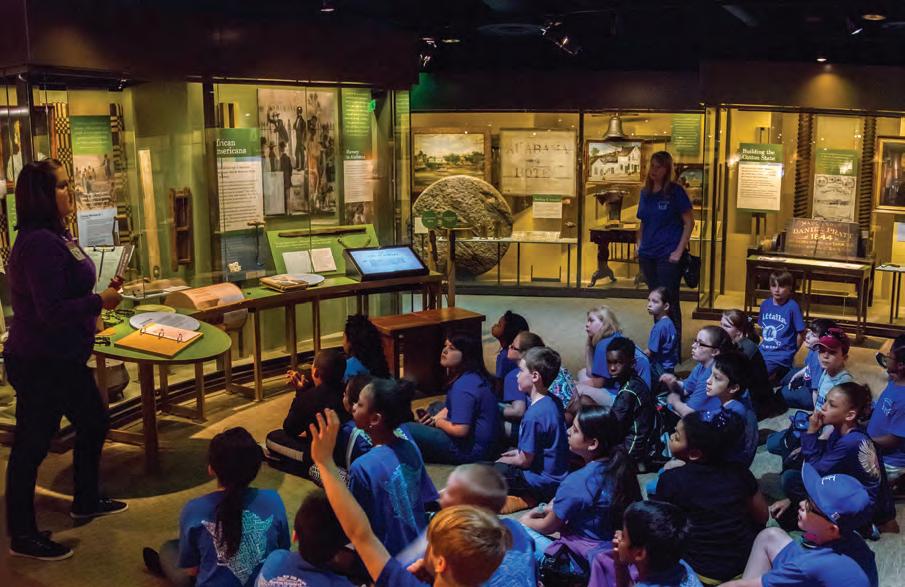
postage paid at Montgomery, Alabama, and at additional mailing office.
POSTMASTER send forms 3579 to:
Alabama Living, P.O. Box 244014 Montgomery, Alabama 36124-4014.
ALABAMA RURAL ELECTRIC ASSOCIATION
AREA President
Karl Rayborn
Editor
Lenore Vickrey
Managing Editor
Allison Law
Creative Director
Mark Stephenson
Art Director
Danny Weston
Advertising Director
Jacob Johnson
Graphic Designer/Production Coordinator
Brooke Echols
ADVERTISING & EDITORIAL OFFICES:
340 TechnaCenter Drive
Montgomery, Alabama 36117-6031
1-800-410-2737
For advertising, email: advertising@areapower.com
For editorial inquiries, email: contact@alabamaliving.coop
NATIONAL ADVERTISING REPRESENTATIVE:
American MainStreet Publications 611 South Congress Ave., Suite 504 Austin, Texas 78704
1-800-626-1181
www.AMP.coop
www.alabamaliving.coop

USPS 029-920 • ISSN 1047-0311


Central
Little
PHOTO:
Diners at Sierra’s in Arab feel like they’re coming home when they encounter the friendliness and enticing smells inside this popular restaurant.




24 32 VOL. 77 NO. 4 APRIL 2024 DEPARTMENTS 11 Spotlight 29 Around Alabama 34 Cook of the Month 40 Outdoors 41 Fish & Game Forecast 46 Cup o’ Joe ONLINE: alabamaliving.coop 16 APRIL 2024 3 WE WANT TO HEAR FROM YOU! ONLINE: www.alabamaliving.coop EMAIL: letters@alabamaliving.coop MAIL: Al abama Living 340 Technacenter Drive Montgomery, AL 36117 FEATURES
dancers
9 Tiny
baller
page! 24 Welcome home
inas love to twirl and show off their dance moves. Just take a look at our Snapshots
32 Trending green
plants with “cyber-lime”
can make your
color. Archives expanding
the Alabama Department of Archives and History approaches its 125th anniversary, it is expanding and enhancing several of its popular Museum of Alabama exhibits to help celebrate this milestone in 2026. ALABAMA LIVING is delivered to some 420,000 Alabama families and businesses, which are members of 22 not-for-profit, consumer-owned, locally directed and taxpaying electric cooperatives. Subscriptions are $12 a year for individuals not subscribing through participating Alabama electric cooperatives. Alabama Living (USPS 029-920) is published monthly by the Alabama Rural Electric Association of Cooperatives. Periodicals
Adding
foliage
landscape pop with
As
Printed in America from American materials Get our FREE monthly email newsletter! Sign up at alabamaliving.coop ON THE COVER Look for this logo to see more content online!
apprentice lineman
is no stranger to hard work, especially when it comes to setting poles. For more about a day in the life of a lineman, see Page 6.
Alabama Electric
Garrett Mahan
Beth Presley

Board of Trustees
Van Smith
Chairman, Billingsley (205) 294-4828
Mark S. Presnell, Sr.
Vice Chairman, Wetumpka (334) 567-2689
Mark Gray
Secretary/Treasurer, Clanton (205) 351-1889
Mike Lamar
Prattville (334) 290-2636
Justin Barrett
Wetumpka (334) 799-4929
Terry Mitchell
Stewartville (256) 249-3128
Nicole Law
Titus (334) 300-2234
James Robert Parnell
Maplesville (334) 259-4408
Chase Riddle
Prattville (334) 365-3648
Charles Byrd
Deatsville (334) 361-3324
Contact Us
Toll Free: 1-800-545-5735
Outage Hotline:
1-800-619-5460
www.caec.coop
Prattville Office:
103 Jesse Samuel Hunt Blvd.
Prattville, AL 36066-6773
Clanton Office: 1601 7th St. North
Rockford Office:
9191 U.S. Hwy. 231
Wetumpka Office: 637 Coosa River Pkwy.

The future of Vegetation Management
While we may not know the answer to the age-old question of “If a tree falls in the forest, does it make a sound?”, we do know that if a tree falls on a utility line, it will cause an outage.
Whether it’s concerning our power or fiber operations, the main recurring challenge we face is unplanned service interruptions caused by trees and vegetation. When trees grow too close to electrical lines, poles, transformers or other equipment, they can not only be the cause of power interruptions, but they can also limit access to electrical equipment when it comes time for routine maintenance or inspections. Additionally, when trees are near energized conductors, they can pose safety hazards to the public and utility personnel. This is why cutting and trimming the vegetation along our right of way (ROW) is a top priority for CAEC.

Through the years, we’ve determined that the leading causes of outages are not trees within our “maintained” ROW, but actually are trees outside the ROW, referred to as danger trees.
Cutting and trimming danger trees has remained a concentration for our vegetation management crews as we perform our maintenance cycles. With thousands of trees outside our maintained ROW, it’s impossible to cut every tree that could potentially hit our power and fiber lines, so we focus on those that are leaning and diseased.
Going forward, our three main ROW focus areas will continue to be removing danger trees, trimming along main lines and ground to sky clearing. In 2020, we began trimming “ground to sky” on our main lines. Before, our contractors trimmed vertically to an approximate height of 70 feet, but since we have much taller trees than this and some are in hard-toreach areas, the use of a helicopter service has proved extremely beneficial. Before and after photos of our recent helicopter service results are pictured here.
As we strive to continue delivering reliable power and lightning-fast fiber internet, we monitor and maintain over 5,000 total miles of line from the constant reliability threat vegetation can pose. As with all of CAEC’s maintenance and capital plans, we continue to analyze and find ways to improve as we provide our members with safe, affordable and reliable service.

 Jimmy Gray VP of Engineering & Operations
Jimmy Gray VP of Engineering & Operations
Powering Up After an Outage
When the power goes out, we expect it to be restored within a few hours. But when a major storm or natural disaster causes widespread damage, extended outages may result. Our line crews work long, hard hours to restore service safely to the greatest number of consumers in the shortest time possible. Here’s what’s going on if you find yourself in the dark: issues.
1. High-Voltage Transmission Lines:
Transmission towers and cables that supply power to transmission substations (and thousands of members) rarely fail. But when damaged, these facilities must be repaired before other parts of the system can operate.
2. Distribution Substation:
A substation can serve hundreds or thousands of consumers. When a major outage occurs, line crews inspect substations to determine if problems stem from transmission lines feeding into the substation, the substation itself or if problems exist further down the line.
3. Main Distribution Lines:
If the problem cannot be isolated at a distribution substation, distribution lines are checked. These lines carry power to large groups of consumers in communities or housing developments.
4. Tap Lines:
If local outages persist, supply lines (also known as tap lines) are inspected. These lines deliver power to transformers, either mounted on poles or placed on pads for underground service, outside businesses, schools and homes.
5. Individual Homes:
If your home remains without power, the service line between a transformer and your residence may need to be repaired. Always call to report an outage to help line crews isolate local issue.
APRIL 2021 5
A day in the life of a lineman
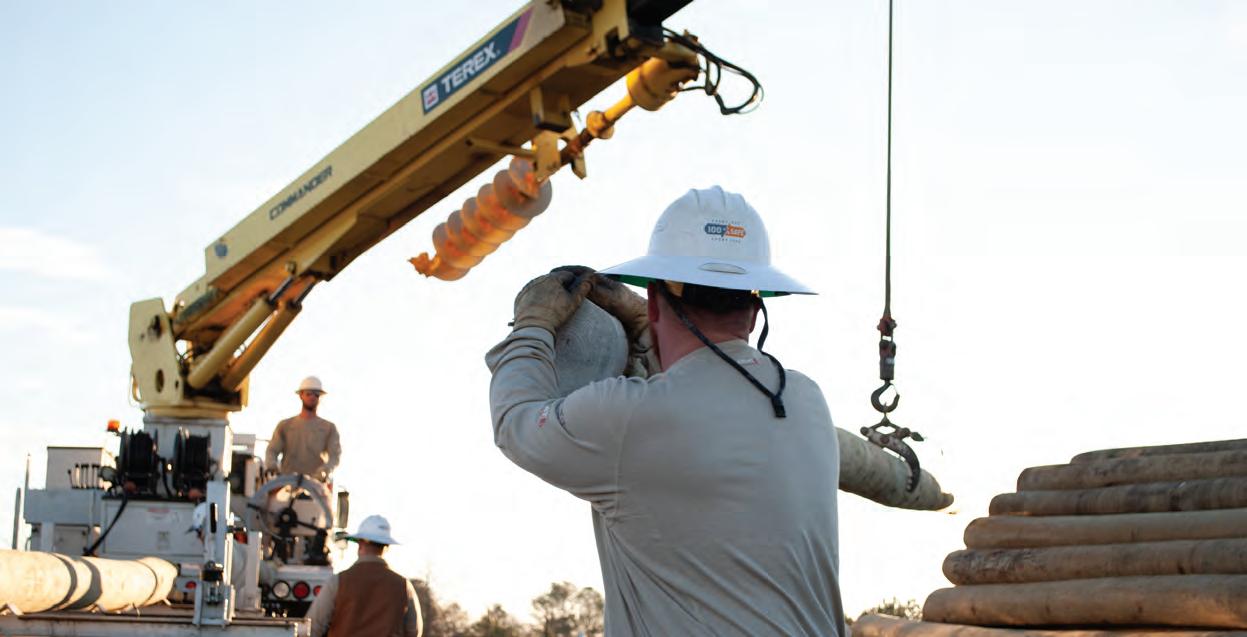



Whether you’ve seen them in action after a storm, passed a bucket truck on the interstate or experienced the relief of power restoration after an outage, everyone has been impacted by the work of a lineman. Their days can be long and their tasks taxing, but for the linemen of CAEC, it’s the industry that they call home.
While many may be familiar with what a lineman is, not as many know exactly what the job of a lineman entails. With this in mind, we’re taking a behind the scenes look into a day in the life of a lineman, showcasing the details of the job, as well as some of the challenges our crews face throughout a typical workday.
CAEC’s linemen start their days before the sun rises, reporting to one of our two operation centers at 6:30 a.m. After proper stretching and warming up, crews meet at the warehouses to load up materials and review jobs for the day. When a job comes in, lead linemen will send work orders and corresponding material lists to the warehousemen; the warehousemen will then gather the materials and have them ready for crews to pick up.
Crews then briefly discuss the job for the day and begin loading the trucks. Once all materials have been acquired and outfitted on the trucks, it’s time to hit the jobsite.
“Once we get to the site, we do a job briefing checklist and review all safety items and hazards of the job as a group,” said CAEC Journeyman Lineman Kyle Hutto. “When we finish going over every section, each member of the crew must sign off on it before it’s submitted. These checklists cover things like making sure we all have the necessary equipment for the job, proper PPE
(personal protective equipment), we know where lines are located, what the weather’s looking like for the day, etc.”
Once everyone has signed off, it’s time to get to work. Crews arrive prepared for their assignments, but as any lineman will tell you, just because it’s on the docket for the day doesn’t always mean that’s the task that ends up getting done.
“You really never know what you may come across when you get to a jobsite,” said CAEC Lineman Caloub Baker. “You get there thinking you’re about to start on one thing, and then you see you have contractors you need to work around or some kind of issue with reaching the area where you need to set a pole. You really won’t know until you get out there and see it up close.”
Projects, unfortunately, don’t always go as planned, and schedules sometimes must be altered on the spot to accommodate these unforeseen circumstances. The ability to think on your feet and adapt to ever-changing situations is key for lineworkers as well as being able to keep a clear head and think through all available options.
Baker. “We may come out here with our assignment and know exactly what needs to get done, but sometimes obstacles just get in the way and slow us down.”
Regardless of the task, teamwork is 100 percent the name of the game when it comes to the job of a lineman as no task can be completed alone. It takes the entire team to make it all come together in the end.

When the job is done and it’s time to call it a day, the guys pack it all back up and return to the operations centers. Once the trucks are unloaded, work time is entered and the day’s paperwork is turned in, the guys are ready to head home.

“No two days are ever the same in this line of work,” said Hutto. “Even if you’re doing the same job you’ve done a million times before, something will always end up being different.”
Whether it’s holding off on one aspect of a project to prioritize another or changing jobsites to ensure progress is made elsewhere, the work of a lineman never stops. Some of these unforeseen circumstances even show up in ways most of us have experienced firsthand, such as getting a truck stuck in the mud.
“This is the kind of stuff people don’t really see or always consider when they think about our jobs,” said
Whether it’s getting a bucket truck out of the mud, utilizing various pieces of equipment to fit into tighter spaces or venturing out in the storm to restore power, CAEC’s linemen are always willing to go above and beyond to get things done right for you, our members. The jobs can be tough and they might not always go as planned, but at the end of the day, these guys wouldn’t have it any other way.

Sp t the truck!






Paying our part
When it's time to restore power, you may see multiple CAEC trucks coming and going. To help you better understand what these vehicles do, check out the information below!
Pickup trucks
We call these trucks the "bird dogs" because they are the first vehicles on the scene after a storm and locate and point out areas to be repaired. Once they survey the affected areas and assess damages like broken poles, downed lines, vegetation debris, accessibility to the area and more, the information is relayed to our dispatchers so crews can be sent out with the most updated stats. Some pickup trucks do have the necessary tools to begin working immediately if the pathways are clear, and these trucks will typically have ladders or other tools present.
Digger derrick and pole trailer
When poles are broken during a storm, you may see the digger derrick and pole trailer arrive with brand new poles to install. You'll know it's a digger derrick because it will look very similar to a bucket truck but on the back will be a large auger that's used to drill holes for setting the poles.
Line trimming crew
If there's significant tree damage or a number of downed trees that hinder us from accessing an area, we call in the line trimming crew. These trucks clear out as much debris as possible to ensure our other vehicles can pass through without issue. While they lend an important hand in getting crews to the affected areas faster, the line trimming crews do not have the necessary tools to begin restoring power themselves.
Bucket trucks
Bucket trucks, both small and big, arrive on the scene for a variety of reasons. If there are downed lines in the area, these vehicles can help get them hooked back up to the poles, or they can be used to perform routine maintenance on the lines. Sometimes they are part of a bigger construction crew that includes the digger derrick and pole trailer.
In 2023, CAEC contributed to regional, state and federal governments by paying nearly $14 million in taxes. Of the $14 million, over $1.8 million was paid in ad valorem taxes. The revenue from ad valorem taxes goes to school districts, volunteer fire departments and other vital services for our communities. CAEC paid over $630,000 in city business licenses and another $169,000 in state and county use tax for the year.
Additionally, sales tax was paid when the cooperative bought goods and equipment. Payroll taxes, totaling over $4.7 million, were paid in 2023. These taxes include employer-funded state unemployment compensation as well as the social security and Medicare taxes funded by both the employee and CAEC. The co-op also paid approximately $2.2 million in gross receipt taxes and approximately $4.3 million in utility taxes.
Tiny Dancer

Dance with My Divine ballet studio in Monroeville. SUBMITTED by Terri Norris, Monroeville, Southern Pine EC.
This is our granddaughter (Becky Youngblood) during her first ballet recital.
SUBMITTED by Pam Johnson, Foley, Baldwin EMC.


My granddaughter, Madelyn, playing in her recital tutu. SUBMITTED by Debby Watkins, Boaz.
Little sister Charlee showing off her moves at big sister’s birthday party! SUBMITTED by Christin Beard, Eva, Joe Wheeler EMC.

Claira Hall was ready for her dance recital. Dancing to “Who took the cookie from the cookie jar.” SUBMITTED by Sherree Borden, Moulton, Joe Wheeler EMC.

Stella Kelley at her first dance recital. SUBMITTED by Debbie Headley, Troy.
Kelsey Veca as she begins her dancing career. SUBMITTED by Dees Veca, Kenner, Louisiana, Baldwin EMC.




Anna’s first dance recital.
SUBMITTED by Kelli Truitt, Smiths.
Molly Kate Asher passes time while waiting for her future aunt to try on wedding dresses. SUBMITTED by Dale Boyd.
Blakeley Walker posing in her recital outfit. SUBMITTED by Hazel Cotton, Foley.

Online: alabamaliving.coop | Mail: Attn: Snapshots, P.O. Box 244014, Montgomery, AL 36124
RULES: Photos submitted for publication may also be published on our website at alabamaliving.coop and on our Facebook and Instagram pages. Alabama Living is not responsible for lost or damaged photos. Send a self-addressed stamped envelope to have photos returned.
June theme: “Dad’s Little Helper” | Deadline: April 26
Snapshots |
Alabama
Alabama Living APRIL 2024 9

Ala., Tenn. co-ops to send volunteers to Guatemala
Volunteers from three of Alabama’s rural electric co-ops will go to Guatemala from April 8-26 to participate in a project to bring electricity to more than 40 households in the community of Las Penas, located in the department of Jalapa. The project is coordinated by the National Rural Electric Cooperative Association (NRECA) International.
Crews from Covington EC, Central Alabama EC and Coosa Valley EC will be joined by volunteers from Middle Tennessee Electric, a cooperative headquartered in Murfreesboro. The linemen will build primary line and secondary line, install transformers and do the service drops for the homes. They will also do the basic internal house wiring for the homes.
The local community will provide poles and some labor, and the linemen from the U.S. will provide skilled labor and materials for construction.
Since 1962, NRECA International has empowered more than 160 million people worldwide to improve their quality of life by providing them access to safe, reliable and affordable electricity.
Liked ‘Cup o’ Joe’ snowstorm column
I just read your article (“Once upon a time, in a snowstorm,” January 2024). Funny, it’s snowing and icy in Alabama now. I live in Dothan. It’s just cold here, no snow.

My husband is working today, and traveling through Brundidge, he passed an SUV with snow still on the top probably coming from north Alabama, but still a sight to see.
Stay warm. I enjoyed your article.
Tammy McDuffie, Dothan
Thank you so much for this story. It put a smile on my face and made me laugh! As I sit here with ice all around, dreading unfreezing the rabbits, ducks and chicken waterers for the 3rd time today.
I look forward to the next one!
Gypsy Brokenwings, Scottsboro
Whereville, AL
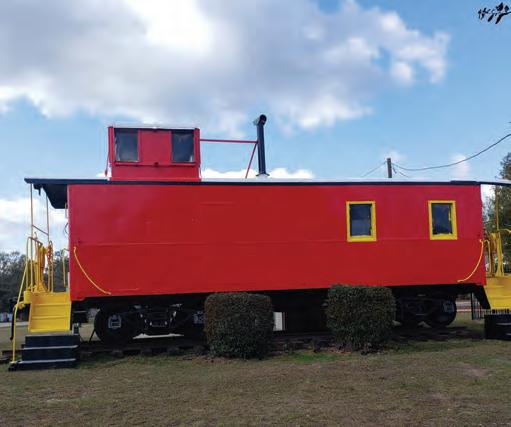
Identify and place this Alabama landmark and you could win $25! Winner is chosen at random from all correct entries. Multiple entries from the same person will be disqualified. Send your answer with your name, address and the name of your rural electric cooperative, if applicable. The winner and answer will be announced in the May issue.
Submit by email: whereville@alabamaliving.coop, or by mail: Whereville, P.O. Box 244014, Montgomery, AL 36124.
Do you like finding interesting or unusual landmarks? Contribute a photo you took for an upcoming issue! Remember, all readers whose photos are chosen also win $25!
March’s answer: This sculpture is in the courtyard of the German POW camp in Aliceville, which has exhibits that chronicle the camp that existed from 1942 to 1945. The annual Camp Aliceville World War II re-enactment commemorates the arrival of the first POWs 80 years ago and celebrates Aliceville’s major contribution to the war effort; re-enactors portraying POWs, American MPs and Alabama State Troopers present a re-creation of the camp. For more info, visit alicevillemuseum.org, and see related story, Page 20. (Photo by Jim Plott) The randomly drawn correct guess winner is David Younce of Baldwin EMC.
T-Ball memories

Just finished reading your article on T-Ball (“Cup o’ Joe,” April 2024). Brought back a lot of memories. I coached the fun league several years. Have two sons, the oldest, now 58 and the younger, 53. The elder could have cared less about sports. Made one trip to the diamond and quickly learned he had rather be elsewhere. On the other hand, his brother loved it all. The best story I want to share with you follows:
One of the other dads always coached first base during practice. Always emphasized to his son, “Hit the ball and run to me.” Came game time on opening day, he was coaching third base. Guess where his son ran when he hit the ball.
Enjoy your stories every month.
Joe Harris, Sylacauga
10 APRIL 2024 www.alabamaliving.coop E-mail us at: letters@alabamaliving.coop or write us at: Letters to the editor P.O. Box 244014 Montgomery, AL 36124 Letters to the editor Spotlight | April
A coffee grower in the area of Las Penas, Guatemala, talks to a survey team from the U.S., which visited the country last fall to scout a project to bring electricity to more than 40 rural homes.
PHOTO BY MICHAEL KELLEY
Take us along!
We’ve enjoyed seeing photos from our readers on their travels with Alabama Living! Please send us a photo of you with a copy of the magazine on your travels to: mytravels@alabamaliving.coop. Be sure to include your name, hometown and electric cooperative, and the location of your photo.We’ll draw a winner for the $25 prize each month. Make sure your photo is clear, in focus and not in shadow.





Find the hidden dingbat!
Nearly 800 of you went Easter egg hunting last month and correctly found the hidden dingbat egg on Page 14, atop the shelf in North Alabama EC Manager Gena Hall’s office. We made it a little bit easier, as some of you wrote us, but that was our little Easter present to you! Some readers said the hunt reminded them of childhood Easter egg hunts, including Lillie Noble of York, who recalled that her mother used Kool-Aid to dye the eggs. “I miss those days,” she wrote. Lin Whittington of Dixie EC said it was the first time entering the contest which they enjoy searching for in each issue, adding, “Thanks for not making me crazy this month.” Ryan Russell wrote that “Normally the first thing I would do is go straight to the recipes. Recently I learned about the dingbat hunt.
By mail: Find the Dingbat Alabama Living
PO Box 244014 Montgomery, AL 36124
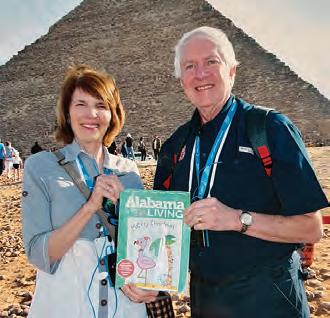

and took the shot for us after we explained what we were trying to do,” they wrote us. They are members of Baldwin EMC.
It reminds me of being a kid and looking through Highlights magazine. I love it and now have a new thing to look forward to each month.” He added that “Gena Hall better make sure she ties up her shelving behind her desk. That egg on the top right could very easily roll right off!” We especially like to hear from our younger readers who hunt the dingbat with their grandparents, like Brooklyn Crouch, 12, and Lily Rodgers, 11, of Satsuma. Keep reading, girls! And Tim Callahan, here’s your mention. Thanks for finding the egg and for reading Alabama Living!
Congratulations to Vanessa Hallmark of Town Creek for being chosen as our randomly selected winner this month. She wins a $25 gift card from Alabama One Credit Union. This month, get out your golf clubs and start “swinging” for the hidden golf ball! Good luck!
By email: dingbat@alabamaliving.com

Sponsored by

Alabama Living APRIL 2024 11 April | Spotlight
Meredith Ann Calvert, Cade Smith, and Ricky and Anna Calvert, all of Cullman EC, enjoyed a trip to Denali National Park, Alaska.
Barbara Green and Dawn Young took their magazine along on a Viking River Cruise on the Danube to see the Christmas markets, traveling from Budapest to Prague. They are members of Tallapoosa River EC.
Diann & Mike Weeks of Auburn and Orange Beach, members of Baldwin EMC, took some good reading material with them to Egypt, where they visited the Pyramids of Giza, built 1,000 years before the birth of Moses.
Michael Mann of Auburn, a member of Tallapoosa River EC, took his copy along while visiting family in Two Rivers, Wisconsin, which claims to be the home of the first ice cream sundae.
Wanda Huff of Crane Hill took her magazine to visit family in Idstein, Germany. Her son, Kevin, who is stationed in Wiesbaden, Germany as Battalion Command Sergeant Major for the 102d Signal Battalion, sent us the photo. His parents, members of Cullman EC, have lived in the Cullman area for more than 50 years.
Jean and Ray Lorentz of Foley took a 10-day Caribbean cruise and one of the ports of calls was Tortola, British Virgin Islands. “We were standing on an Island in the middle of the Port Entrance road wondering how to get our photo taken together, when another tourist crossed over
Restoring your power:
Perspectives from two linemen
When your electricity goes off, the first question most of us ask our electric cooperative is: “When will my lights come back on?” That’s something our linemen get asked quite often, so in recognition of Lineman Appreciation Week this month (April 15-19) we wanted to share with our readers the perspectives of two of our Alabama co-op linemen, in two different parts of the state. While they live hundreds of miles apart, these two linemen share very similar experiences, and both are dedicated to restoring your power quickly and safely.
By Jarred Whitaker, Marshall-DeKalb EC
Ilove to help people. That’s just what I do. It is all about seeing the expression on the face of someone who has been in the dark for several hours or days, when we can restore their power. I feel like I have done my job. Sometimes, you can’t see them, and you only hear cheers of happiness when you flip the switch. What job could top that?
Sometimes it takes longer than you expect, and our members get frustrated and voice their concerns. They just don’t understand the process of what it takes to get the power back on. So let me take you through the process of what we do at Marshall-DeKalb EC during power outages, and hopefully, I can shed some light.
The Outage Begins
6 p.m.: The lineman on call receives the first report of an outage. Every week, MDEC has three men on standby 24/7. On weeknights, weekends, and holidays, someone is always there. During normal working hours, calls are received through the office, but after hours, calls are received through our answering service. When you report an outage, they relay to the lineman your location number, address, and any other important information you tell them. From here, our linemen leave as quickly as they can. The MDEC system covers Geraldine to Douglas, Guntersville to Boaz, and Dawson to Nixon Chapel. Travel time does factor into response time, and often, a lineman may be on another call when your lights go out. But know that someone is trying to respond ASAP when your lights are out.

Arrival and inspection
7 p.m.: We spend a lot of training in visual inspection. From the time the first call is placed until “arrival,” more outages may have been reported, especially if the whole line is out. If emergency crews are present or a customer has seen something helpful to us, that will help the situation normally. But if you see us drive by your house several times, I promise we are not joyriding but checking for multiple things. The first time may be to see if you’re the only one who is out or if the line is out. You would be surprised at how often a whole line, road, or neighborhood is out,
but only one customer has called. So we drive to the source to see if the “device” is open or closed. If it’s open, then we must determine what caused the outage. Sometimes this is the most time-consuming step. But we cannot, and I stress, cannot energize a line until we are 100% sure the public is safe. If it is dark outside or if it’s stormy, this just adds time. When you see us drive by, we are looking for what caused the outage. Examples can be downed trees, tree limbs, and lightning; most common in our area are squirrels and/or car wrecks. Also, MDEC is an electric cooperative. We are trying to move more lines closer to the road, but we have a lot of lines that go across pastures, across fields, and through the woods. So, terrain matters. We often must set out on foot to walk our lines to inspect inaccessible areas.
Outage case located
8 p.m.: Safety comes first! Sometimes outages are easy. A squirrel may have blown the fuse on a transformer, affecting only one customer. Those outages are easy and can be fixed quickly. But what happens if a tree falls across the main line, tearing down the line? At MDEC and all electric companies, we have safety steps that must be followed. These steps are vital to us. Although I love our members and want your lights back on ASAP, I’ve got a wife and two sons at home who depend on me and expect me to return home safely. The same goes for my co-workers. Our safety procedures allow us to work safely in a dangerous job and protect the public. We’re all in this together! So, we
12 APRIL 2024 www.alabamaliving.coop
Jarred’s wife, Terra, and sons, Weston and Lucas, stand proudly with their lineman. PHOTOS BY KELLI WHORTON

find the source and check for the cause. The switch or device is open, the tree is on the line, or the line is down, so we ground both sides of where we’re working to protect from back feed and the unknowns. Then, we hold a job briefing or tailgate discussion with all workers present so everyone knows what to do, what has been done, knows when to do it, and answer any questions or concerns.
Work begins
8:30 p.m.: All safety procedures are in place, and work begins. If a tree is down, we would remove the tree. Those who use chainsaws know this is dangerous, especially if the tree is on the line and is under pressure. If the wire is completely broken, then we will put the line back up. If the line is a three-phase, we may have a broken cross-arm. No matter the case or what has been broken, the repairs will be made. Earlier, we talked about lines in rural areas or through the woods. These lines may not be accessible with trucks. If so, the lineman must climb the pole to make repairs. This, too, can add time. Repairs have been made, grounds are removed, and now we are ready to re-energize the line.
9:30 p.m.: When you see us drive by this time, it’s good news. We’re heading back to the source to close the switch or device. Once everyone is in the clear, we re-energize the line, and your lights are back on.
Power restored
10 p.m.: Please keep in mind this is only one scenario. Not every outage is the same. A broken pole or car wreck will take more time. We are improving daily. Technology is so advanced, and we constantly try to stay on top. From our metering system to our new mapping system, time frames are much shorter than they used to be. We, as linemen, just ask you to be patient and understand there is a method to what we do to keep everyone safe. Those of us who are on call have missed birthdays, family gatherings, Thanksgiving dinners, and even Christmas mornings to keep the lights on. But that’s what we do. We’re a part of this community. We’re neighbors, friends, we’re family. We take great pride in keeping the electricity on. For doing whatever it takes, however long it takes, no matter when, 24 hours a day- 7 days a week- 365 days a year, you can always count on MDEC!
Restoring your power: Focusing on safety and problem-solving
By Jeff Malone, Baldwin EMC
Like my fellow linemen, I like to help people and love being a lineman. It truly is a great feeling to be able to restore comfort, convenience and security as you restore power.
Jarred’s step-by-step account helps you see what we see. I am going to try to help you understand what we are thinking and feeling as we restore power.
The Outage Begins: Focus on solving the problem
These days, a 6 p.m. outage doesn’t cause me too much stress. I’ve been a lineman for… well, let’s see… I started when I was 20, and I’m 53 now. So, 33 years. Back when my children were younger and I had more family commitments, it was tougher on us. It’s tough on guys with young families now. Because a 6 p.m. call could come in the middle of an important dinner or in the middle of your kid’s big game. And in 33 years, I’ve missed quite a few. That’s our job, though. We can’t focus on what we are leaving when we get that call. We must focus on safety and solving the problem. We learn a lot from the outage details provided on that call. We are thinking about the number of meters affected by the outage, the vicinity of the outage and cross-referencing the additional information shared. Even before we arrive, we are imagining our system, the circuits in the area and establishing possible causes and a plan. We are preparing both physically and mentally for what we are going to encounter. Unfortunately, the cause is sometimes worse than the outage. Car accidents, house fires and man-made outages are the worst possible scenarios.
Arrival and inspection

zone to protect us, our equipment and the public from danger.
Outage case located: Safety at the forefront
When we arrive, there are a lot of things running through our heads as we are doing our visual inspection. Depending on
the amount of damage or the location of the outage, we are determining if additional crews are needed to help restore power safely and efficiently. We don’t want the outage to linger, but we also don’t want to pull more crews away from their families and plans if we can get the job done. We are also determining if we can isolate the outage and do some switching, which is ultimately just redirecting the power around the outage to get some meters restored before the damage is repaired. Once the damage is located, we are thinking about every safety measure needed to protect us and you. No two outages are the same, so we must think clearly through every step. We are also thinking about what hazards exist besides what caused the power outage. These days, traffic is a major concern, and distracted driving is never far from our thoughts. We are thinking about how to set up our work
Once the outage is located and before repairs begin, we will perform a tailgate discussion to identify hazards, ensure everyone is on the same page, and ensure that each part of our plan is clear. Once it is established who is doing what, we put on our PPE (personal protective equipment), test for voltage and apply personal grounds. We also apply insulating materials as another measure of safety. Years ago, linemen would disconnect power before they started to make repairs, and in some cases, that is still required; however, a lot of times we work on energized lines to prevent further inconvenience to additional members. This is just one of the reasons our job is classified as one of the most dangerous. We are really thinking about how we can have the least amount of inconvenience for you as we make necessary repairs while keeping safety at the forefront of our minds.
Work begins
It is finally time to start working to repair the outage. We have the necessary training, tools and team members. Years of specialized training and an uncompromising commitment to communication are paramount as we start making repairs. We had a speaker tell us one time that we must “be where our feet are,” and that is so true. You can’t daydream when you’re literally handling 7,200 volts of electricity. Every step must be calculated until every repair is made. Even the act of bringing power back on after the repairs are made requires communication. We realize there are no short cuts, no apologies and no excuses because electricity doesn’t give you a second chance to get it right. That’s always on our mind during this phase.
14 APRIL 2024 www.alabamaliving.coop
Jeff Malone (second from right) is pictured with his wife Emily and their sons Will (far left) and Jay. PHOTO COURTESY MALONE FAMILY
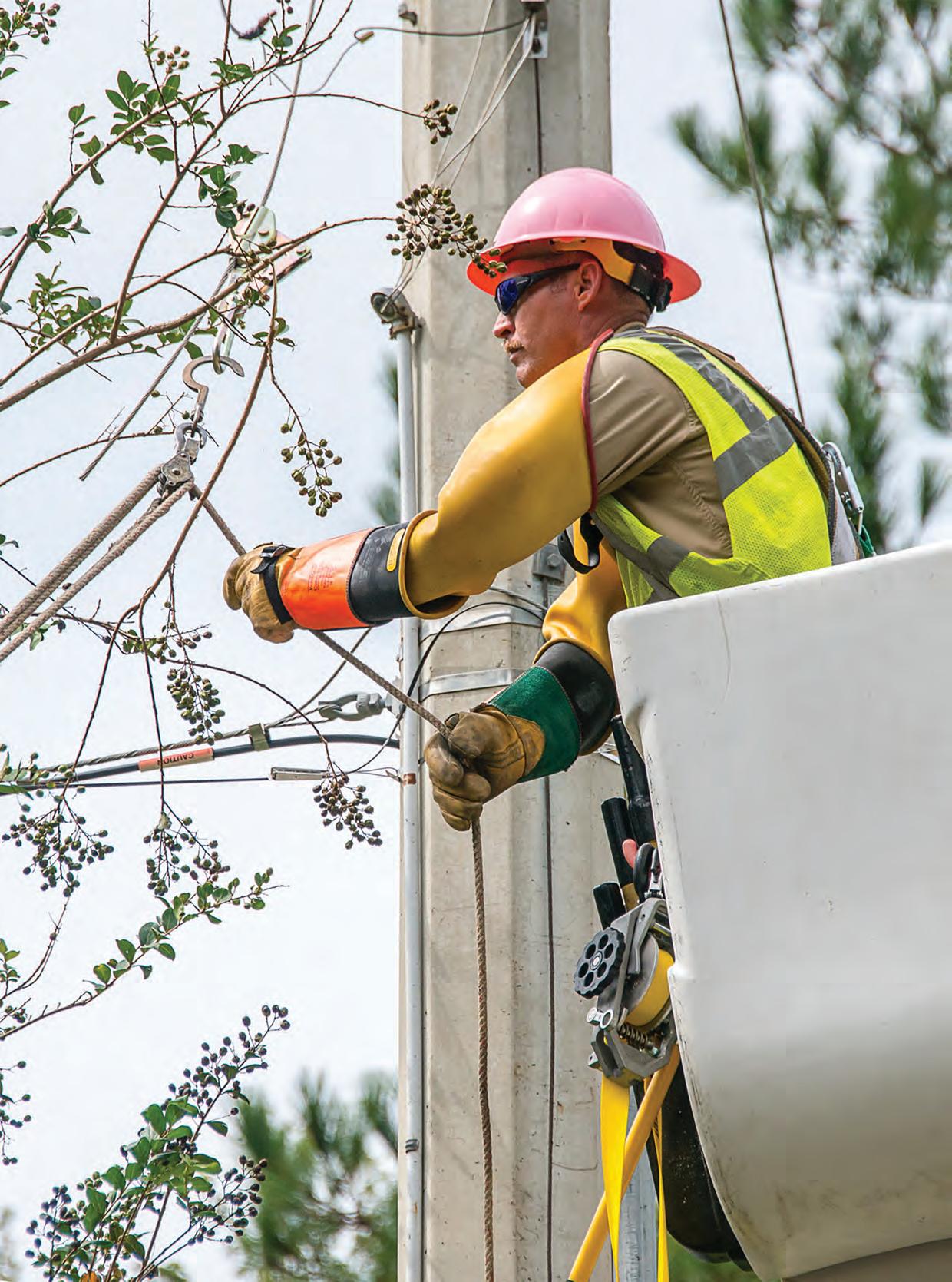
Power restored: Thankful on many fronts
Now, gratitude is what we are feeling. Even after 33 years, getting power restored still feels great! We are thankful that the power is back on for you, and we are thankful we are on our way home. If this had been a middle-ofthe-night outage, we would be thankful for the few hours of sleep we would get before we report to work the next morning. We are thankful for the job worked safely and being able to return to the people who love and care about us. We are thankful for the way we have learned to quietly enter our homes after a late-night return and not even disturb those who are sleeping. We are thankful for the calling on our lives, the ability to be linemen and the company we work for that provides power to our communities. Lastly, we are thankful for you. We are thankful for your patience and how you, as a member, make this job so personal.
PHOTO BY TAD DENSON

Archives and History expanding to reach new generations
By Carrie Banks
Alabama has a vibrant, multilayered history, and the Alabama Department of Archives and History (ADAH) has been the caretaker of our individual and collective stories since its inception in 1901 as the first state-funded historical and archival agency in the country.
As the ADAH approaches its 125th anniversary, it is expanding and enhancing several of its popular Museum of Alabama exhibits to help celebrate this milestone in 2026.
ADAH Director Steve Murray says the projects will help the museum speak to new generations.
“These upcoming improvements will build on the foundation we began more than a decade ago that expanded our K-12 services and our capacity to serve the public in the digital sphere,” he says. “They will be a significant springboard to enhanced engagement with audiences and an ongoing demonstration of the relevance of our history.”
dren can talk in a telephone booth, try on vintage clothes, type on a typewriter, cook over a stove, or attend or teach school. Over the next two years, Grandma’s Attic will become a new, reimagined Children’s Gallery intentionally designed for the youngest visitors, ages 2 to 10.
The new Children’s Gallery will feature flexible learning stations that include the most popular activities from Grandma’s Attic as well as age-appropriate Alabama history topics. Because of its focus on engaging history and civics concepts through play, this new gallery will also function as a learning lab that equips families and educators with ideas, methods, and content to share as their young students continue to learn while having fun.

Alabama Voices expands
Since 2014, the ADAH’s centerpiece exhibition, Alabama Voices, has told the story of Alabama from 1700 to the current day to thousands of schoolchildren, Alabamians, and visitors from around the globe. To enhance this award-winning exhibit for a new generation, outdated audiovisual equipment, lighting, and scenic elements will be replaced and additional interactive stations as well as digital labels will be installed to accommodate the evolving learning styles of visitors in the digital age.
New Children’s Gallery
For many years, one of the most popular areas of the ADAH has been Grandma’s Attic, an interactive play space where chil-
Redesigned gallery will explore The First Peoples of Alabama
In 2011, The First Alabamians gallery opened and was immediately popular for school field trips and the public. However, because many of the artifacts displayed were taken from Native American burial sites during the early 20th century, the ADAH closed The First Alabamians in 2022 out of respect for its tribal partners. The ADAH is now actively working with tribal representatives and scholars to envision a new presentation of the complex, multi-layered story of our state’s first peoples through interactive programs, artifacts, reproductions, and graphics not based on funerary items.
Permanent gallery shares military stories
Guided by an advisory group of veterans, active-duty service members and scholars, a new gallery will share the experiences of
16 APRIL 2024 www.alabamaliving.coop
The award-winning Alabama Voices exhibit will be enhanced with new audiovisual equipment, lighting, and scenic elements, along with interactive stations and digital labels to accommodate the evolving learning styles of visitors in the digital age. PHOTOS COURTESY DEPARTMENT OF ARCHIVES AND HISTORY
A new permanent gallery will share the experiences of Alabamians in military service.


Alabama Living APRIL 2024 17 THANK YOU Alabama’s Electric Cooperatives Lineman Appreciation Week Lineman Appreciation Week Lineman Appreciation Week CELEBRATES APRIL 15-21
Alabamians in military service and explore the effects of service on lives and communities during times of war and peace. This new interpretation will be designed to honor military history and expand the visitor’s understanding of the courage and cost that comes with answering the call of duty.

Our stories live here
The ADAH is dedicated to collecting and preserving the state’s historical materials to share thoughtful versions of Alabama’s stories so visitors will understand that Alabama’s history is for everyone. In addition to preserving history and developing educational programming, the ADAH operates a dynamic and recently redesigned website (archives.alabama.gov) that serves as a resource for local governments, libraries, educators, and the public.
Announcements for upcoming public programs and new exhibitions are regularly added to the site’s homepage, where visitors will also find a link to the online museum store featuring Alabama books, artists, and handmade products. The site also features access to the ADAH’s extensive digital collections (photos, maps, films, manuscripts), electronic records collections, and multiple databases. Additional resources are available to in-person visitors.
“We are ever mindful that the work performed at the ADAH today rests on the foundations laid by our founders and the frameworks built by succeeding generations of committed board members and staff,” Murray says. “We are merely the current generation of stewards with the awesome responsibility of caring for the public’s resources on their behalf.”
Located across the street from Alabama’s State Capitol in downtown Montgomery, the ADAH, including the Museum of Alabama, is open Monday through Saturday from 8:30 a.m. to 4:30 p.m. with guided tours available for groups of 15 or more. The Archives Research Room is open Tuesday through Saturday from 8:30 a.m. to 4:30 p.m. Admission and cost for group tours are always free.
ADAH by the numbers in fiscal year 2023:
• Total archival holdings: 72,403 cubic feet
• Total museum artifact collection: More than 400,000 objects
• Museum visitors in FY23: 30,191
• K-12 visitors: 19,209
• 99% of teachers surveyed rated their Museum of Alabama field trip experience as “excellent”
• 915,612 digitized items are available at digital.archives.alabama.gov
• 47 public programs were presented in FY23, totaling 51.5 hours and are available on YouTube
 The Department of Archives and History is located across from the State Capitol in downtown Montgomery.
More than 19,000 schoolchildren in grades K-12 visited the Archives in 2023.
The Department of Archives and History is located across from the State Capitol in downtown Montgomery.
More than 19,000 schoolchildren in grades K-12 visited the Archives in 2023.

Event commemorates Pickens County’s POWs
Event commemorates Pickens County’s POWs
By Jim Plott
Listen.
That’s the sound of German soldiers marching in cadence.
But they are not heading off to battle. For these soldiers the war is over.
These weary, haggard, but still proud Germans are marching toward their new home for the duration of World War II – on U.S. soil.
Camp Aliceville in Pickens County stood as one of the largest prison camps in the U.S. during the war. At its height it housed 6,150 German prisoners, most of whom were part of Field Marshal Erwin Rommel’s Afrika Korps.
While history might not replay itself, it can try to mirror it – although on a smaller scale. On May 3-4, the town of Aliceville, the camp’s location, will try to relive those wartime days on the home front.
ment includes that day in early June 1943 when the town’s people turned out in curious masses to witness the first 500 German POWs being unloaded from Pullman train cars and marched more than a mile to the camp that for many was their home for the remainder of the war.

The event will start Friday with a screening of a World War II movie and other features at the Aliceville Entertainment Complex. The old movie theater was donated to Aliceville Museum. The museum is home to what many say is the biggest display of German POW artifacts in the United States.
On Saturday re-enactments will be conducted. One re-enact-
That day re-enactors will portray POW camp life and stage one of the few escape attempts from the now dismantled 800-acre prison camp that once was filled with more than 400 structures. Re-enactors will also stage a mock skirmish from the battle at El Alamein in North Africa where German forces surrendered to the British.
The event will be capped off with a USO Big Band Swing Dance and Dinner at Aliceville City Hall from 6 to 10 p.m. The Drew White Orchestra of Florence will be playing popular songs of the Big Band and WWII era. There is an admission.
“It’s a big day for Aliceville and the Aliceville Museum,” said John Gillum, executive director of the Aliceville Museum. “The first year that we did it, the museum experienced its biggest day in history in terms of visitors.”
Brien McWilliams, spearheading the re-enactment, emphasizes the importance of Aliceville and the war period in history.

 This will be the third re-enactment of the Aliceville POW Camp.
PHOTO COURTESY OF ALICEVILLE MUSEUM
The actual march from the Aliceville Train Depot to the POW camp occurred on June 2, 1943.
PHOTO COURTESY ALICEVILLE MUSEUM
This will be the third re-enactment of the Aliceville POW Camp.
PHOTO COURTESY OF ALICEVILLE MUSEUM
The actual march from the Aliceville Train Depot to the POW camp occurred on June 2, 1943.
PHOTO COURTESY ALICEVILLE MUSEUM
20 APRIL 2024 www.alabamaliving.coop
This chimney from the non-commissioned officer’s club is the only vestige of Camp Aliceville, which had 400 buildings. PHOTO BY JIM PLOTT

“History, good and bad, needs to be remembered,” said McWilliams, who participates in numerous re-enactments including WWII-era battle scenes at the U.S.S. Alabama in Mobile and the Creek Indian attack at Fort Mims in Baldwin County. “I consider those Americans who were involved in World War II as our greatest generation and that history needs be kept alive.”
Why were they here?


In 1943, Allied forces defeated German and Italian armies in North Africa and captured 275,000 enemy soldiers. The U.S. military decided to move them to the United States, and the Army Corps of Engineers worked quickly to establish camps in nearly every state. By 1945, the nation was host to more than 500 camps with some 425,000 POWs.
Two sites in Alabama were chosen – near the town of Aliceville, and one near Opelika. Camp Aliceville became Alabama’s largest POW camp, with a capacity for 6,000 prisoners. Another smaller camp was constructed near Fort McClellan, and a fourth in what was then Fort Rucker.
When the first Germans rolled in to Aliceville, P.M. “Pep” Johnston, now 93, had a front-row seat to the actual event. Johnston, then 12, and his family, like basically the entire population of Aliceville, disregarded appeals to stay home the day the Germans arrived.
“Most of us didn’t know what to expect since there had been so many rumors going around about who was to be housed in the camp,” Johnston recalls.
Johnston recalls people lining the main route from the depot to the camp while others took seats on porches, rooftops, on car hoods and the back of pickup trucks.
“(The Germans) had on the same dirty and soiled uniforms as we found out later from when they were captured in North Africa,” Johnston says. “They got off and formed platoons and marched toward the camp. Obviously, I did not know much about the military at the time, but I could tell they were well disciplined despite their condition.”
Johnston later got a closer glimpse of the POWs when several of them were employed at his father’s sawmill. One even did a drawing of the younger Johnston.
POW pampering
The camp was a comfortable home away from home for the German POWs. They settled into the camp and over time formed art and pottery classes, held theater and puppet productions and even formed several bands that performed at American officer functions. They also played sports and produced a camp newspaper from a printing press they bought in Jasper.
“There was a lot for them to do because you wanted them to stay busy rather than cause trouble. They could pretty much organize what they wanted to do within reason,” Gillum says. “In terms of quantity they ate better than most of the people in Aliceville, which was still coming out of the Great Depression. The thought was if we treat them good, the Germans would treat our guys being held in their prisons good. We now know that didn’t happen.”
The Germans also were served what no one in Aliceville could get – beer. That’s because Pickens County was a dry county so no
alcohol could be sold, Gillum says.
After the war, the camp was dismantled, and the POWs were repatriated to their devastated homelands. In the decades after the war, a number of POWs returned to Alabama to reconnect with their past.
In the 1980s Sue Stabler, a longtime resident, issued a call to build a museum to commemorate Camp Aliceville. Residents and others began donating camp-related items, and over time even some former POWs began making contributions. The donation of the former Coca-Cola bottling plant building helped the museum grow.
Also in the 1980s and 1990s, the museum hosted several camp reunions involving camp guards and POWs, many of whom had formed close friendships. That ended when many Americans and Germans died or could no longer travel because of health.
Yet, Gillum said it is not uncommon for the children or grandchildren of the POWs to visit the museum.
“About 10 percent of our visitors every year come from Germany and a lot of times when they come, they bring items to donate that belonged to relatives who were POWs at the camp,” Gillum said. “Items from the camp keep showing up here whether they are from the Germans or relatives of Americans who were guards here. So, the museum keeps growing.”
Some information in this article is from the Encyclopedia of Alabama.
2024 Aliceville Prisoner of War Camp Reenactment Schedule of Events
Friday, May 3
All day: Camp set up at POW compound (Memorial Parkway at Broad Street Intersection)
6 to 8 p.m.: WWII period movie, “The More the Merrier” (comedy, 1943) with cartoon, World War II newsreel at the Aliceville Entertainment Complex, 210 Broad Street NE. Free. Doors open at 5:30 p.m., movie starts at 6 p.m.
Saturday, May 4
• 10 a.m.: Re-enactors prepare for Battle of El Alamein (POW Compound)
• 10:30 a.m.: Allied vs. Axis Skirmish (Battle at El Alamein and German Surrender)
• 11 a.m.: Re-enactors transported to railroad crossing area on 3rd Avenue
• 11:30 a.m.: Re-enactors commence POW march on 3rd Avenue to Memorial Parkway to Broad Street stage area
• 12 p.m.: Official welcome of spectators, guests, and re-enactors to Aliceville by dignitaries at Broad Street and 2nd Avenue
• 1 p.m.: Pr isoners roll call and mail call at POW compound
• 1:30 p.m.: Funeral for Rommel by German POW re-enactors
• 2:30 p.m.: POW re-enactor escape attempt
• 3:30 p.m.: War ends; parole of German POW re-enactors and discharge of American Army re-enactors at POW compound gate
• 4:30 p.m.: Re-enactment event concludes
• 6 to 10 p.m.: USO Big Band Swing dinner dance at Aliceville City Hall Auditorium, 419 Memorial Parkway
Visit Camp Aliceville WWII POW Camp Reenactors Group or Aliceville Museum on Facebook.
22 APRIL 2024 www.alabamaliving.coop
A senior Pep Johnston and as a youth in a drawing done by a German POW.
PHOTOS BY JIM PLOTT

Sierra’s:
More than a Mexican restaurant in Arab
By Lenore Vickrey
Visitors to Sierra’s Mexicanismo Restaurant in Arab always feel welcome when they come through the front door. That’s because they are greeted by a colorful chalkboard featuring a festive fellow in a Mexican sombrero brandishing a taco atop the sign that says, “Welcome Home.” It immediately sets the tone for the family-owned and operated restaurant that’s been a popular mainstay in this northeast Alabama town since 1999.
“This coming July it will be 25 years!” proudly proclaims owner and founder Alex Sierra.
Sierra always had a dream to open his own steakhouse. A native of Mexico, he emigrated to the United States with his family in the 1970s as a 7-year-old and grew up around the restaurant business in the Atlanta area, learning from his cousins who ran the El Toro chain there for more than 30 years.
“When I was a child I would visit my grandmother and we visited my cousin’s restaurant and my uncles worked there,” he recalls. He worked in those restaurants as a teenager, then later worked for Frontera, now part of the powerhouse Norsan group, learning all aspects of the business. In 1998, some of his co-workers invited him to join them in opening four Buena Vista restaurants in some smaller north Alabama cities, including Arab.
“Arab was the last one that opened,” he says. After the partnership split, Alex Sierra, tired of driving from location to location, decided to put down roots in Arab and kept the local restaurant for himself. “I changed the name to Sierra’s,” he says. “It was the best decision ever. Same location, different name.”
Since that day in July 1999, Sierra’s
Sierra’s Mexicanismo
1092 N. Brindlee Mountain Parkway Arab, AL 35016 256-93-8226
Look for their page on Facebook and follow on Instagram Hours: 11 a.m. – 9 p.m., daily

Arab l
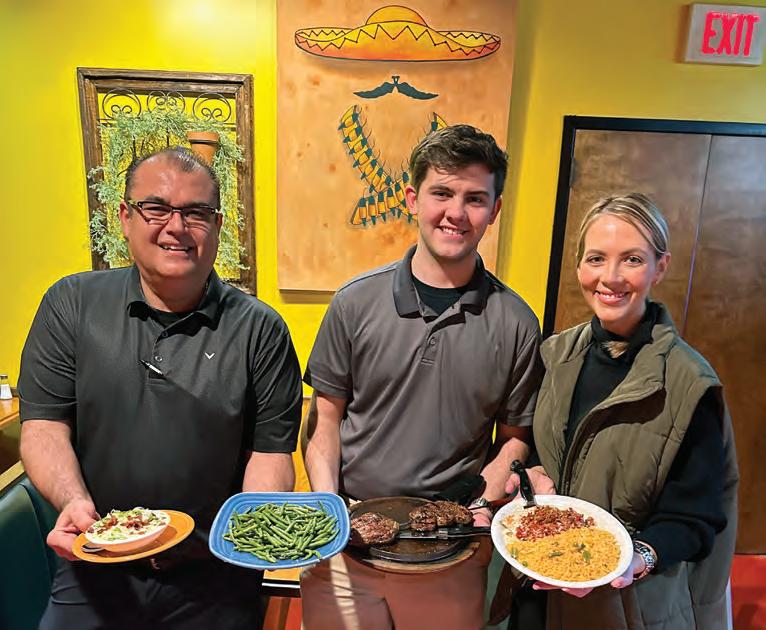
has grown beyond just being a Mexican restaurant. “There was no steakhouse around here,” he says, so he started offering “American steaks with a Mexican flair. That’s with peppers and onions and on a sizzling plate.” He’s also added pork chops and “colossal” shrimp to diversify the menu.
“We’re the only Mexican restaurant in the area, as far as I know, selling prime cut meat,” Sierra says. “We’ve been doing that for nine years. I want to serve the best money can buy. It’s all about the quality of the meat.”
Sierra’s ribeye (the menu also includes a bone-in option) comes out hot and juicy on a heated platter, and ranks at the top of the current four favorite entrees, along with the pork chops, hamburger steak (made with fresh ground “never frozen”
chuck, and ends of the ribeye) and his original creation, Lola’s Chicken, a chicken breast topped with fire-roasted pimento, bacon and Sierra’s creamy cheese sauce, served with rice. “It’s a hit!” he exclaims.
The latter dish is named for Sierra’s daughter, Lola, 15. When not playing soccer, she helps out as hostess/cashier and runner, and his son, Kaden, 20, is the manager. Their mother, Crystal, is an integral part of the operation as well, responsible for human resources, bookkeeping, scheduling caterings and overseeing daily operations.
Coming on fast in the popularity department is the beef tenderloin, Sierra says, accompanied by fresh-cut fries. The Mexican Mash, a side dish of Yukon potatoes, boiled, mashed and combined with “a lot of butter,” Land o’ Lakes sour cream,
24 APRIL 2024 www.alabamaliving.coop
| Worth the drive |
Sierra’s Mexicanismo in Arab serves up specialties including Mexican Mash, fresh green beans, sizzling ribeye steak and Lola’s Chicken, as shown by owner Alex Sierra, his son and manager Kaden, and wife, Crystal.
PHOTO BY LENORE VICKREY



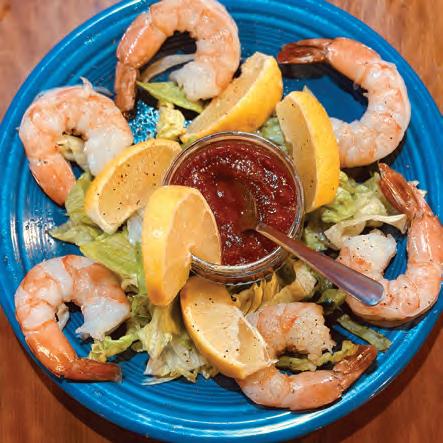
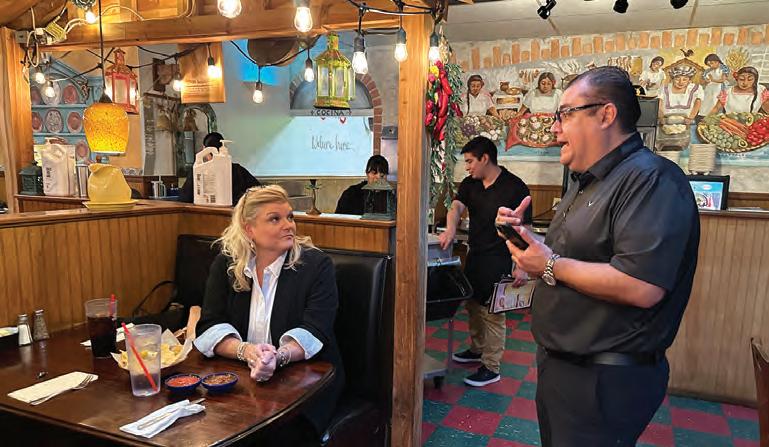
thick-cut bacon bits and topped with green onions, is another original creation. “That truly is my recipe,” he says. “It’s better than the monster mash!”
Of course, Sierra’s has no shortage of traditional Mexican fare from fajitas and burritos to quesadillas, tacos and nachos, enchiladas and salads, and any combination of the above. Salads are served on an ice-cold plate, freshly made with homemade ranch dressing. Most vegetables are fresh, organic and when in season, locally sourced, such as tomatoes from the nearby Chandler Mountain area.
The restaurant offers desserts, but often guests are too full of their chips, salsa and entrée to eat any, he says. But in case they do, there are sweet sopapillas topped with co ndensed milk and milk chocolate.
Why the “Welcome Home” greeting at the store’s entrance? Sierra says it hearkens back to his early days trying to get the restaurant off the ground and he was working long hours by himself. “Between 1 and 5 p.m., I would be all by myself. In the front of the house, I was a one-man show. When customers would come in, I’d take their order, bring chips and salsa to their table, and cook their meal. If I’m in the back and another customer comes in, I’d ask them, ‘Will you welcome them home? Tell them Alex is in the back.’” That way he became friends with his guests and it paid off. Customers still feel like they are
coming home when they visit.
During the 2020 pandemic, like many restaurants, Sierra’s came close to shutting down for good. “We were within days of saying ‘adios,’” he recalls. They closed for the first two months but continued to pay their employees. They offered curbside meals for pickup and “We are so grateful for the people who came and bought food,” he says. Some would leave a $100 tip to be divided among the staff. “Oh, my God, the kindness of a wonderful community…”
Many of his employees have been with him for several years, including the chef for 23 years and his brother, 22 years. “When you treat your people right, they stay,” Sierra says.

Sierra’s values its role in the community, offering scholarships to high school seniors who need help. And student employees who make straight As on their report cards can earn $1 more per hour. “We keep track and try to help kids who need it,” he says. “A lot of the kids who used to work here come back and work at Christmas or in the summer. We want these kids to succeed.”
Alex Sierra has worked in bigger cities but says Arab is now his home and he loves it there. “In my entire life, I’ve had four jobs. This is my last job” he says. “There’s no place like Alabama, and nothing like a small town to raise a family.”
Like the sign says, it’s a true welcome home.
26 APRIL 2024 www.alabamaliving.coop
Arab Electric Cooperative Manager Stacey White chats with Alex Sierra about some of the restaurant’s specialties.
PHOTOS BY LENORE VICKREY
A Welcome Home sign greets patrons as they enter the restaurant.
Sierra’s, located on N. Brindlee Parkway in Arab, celebrates 25 years in business this year.
Colossal Shrimp is a popular dish.
PHOTO COURTESY OF SIERRA’S
Lola’s Chicken, chicken breast topped with fire-roasted pimento, bacon and cheese sauce, is named for Sierra’s daughter.

Plan for your future during Financial Literacy Month
We celebrate Financial Literacy Month (FLM) every April to promote financial education and well-being in the United States. FLM also serves as a reminder that Social Security is a vital part of any financial plan. Our online tools are ere to help you understand your potential Social Security benefits

and how they fit into your financial future.
You should periodically review your Social Security Statement (Statement) using your personal my Social Security account at ssa.gov/myaccount. Your Statement is an easy-to-read summary of the estimated benefits you and your family could receive, including potential retirement, disability, and survivors’ benefits.
If you’re planning to retire, you can visit our Plan for Retirement webpage: ssa. gov/prepare/plan-retirement. Here you can compare how different future earnings
and retirement benefit startdates might affect your future benefit amount.

Please tell your friends and family about the steps they can take to improve their financial knowledge by exploring their personal my Social Security account. If they don’t have an account, they can easily create one at ssa.gov/myaccount

April crossword
Across
1 “When a Man Loves a Woman” singer, Leighton born Percy ____
4 “ Boulder to Birmingham” singer- Emmylou _____
9 “Mountain Music” band
10 “I Heard it Through the Grapevine” singer, Marvin
12 ‘’Midnight at the ___’’ song
14 Tuskegee born singer who sang “Three Times a Lady”
1 7 “I Want My ___”
18 ___ Hawkins, jazz great who is a charter member of the Alabama Jazz Hall of Fame
23 Vane direction, abbr.
24 Heart song from 1985
25 Tuskegee band who sang “Lady (You Bring Me Up)”
2 7 Scott Joplin, “the king of ____time”
29 Barrel
31 B irmingham-born jazz composer who led the Arkestra, 2 words
34 Morsel a horse’ll eat
35 Wonder’s “years of bad luck”
36 “Sweet Home Alabama” band, ____ Skynyrd
Down
1 She’s known as the “First Lady of Southern Soul”, Candi _____
2 Swing, for one
3 Blue ____ music
5 Oscar-winning director Lee
6 Music beat
7 Therefore
8 Admonishment to a puppy
11 Bessemer born singer with the O’Jays who sang “Love Train”Eddie _____
13 Play a guitar
14 Regret
15 Computer people
16 Oboe or clarinet, as instruments
19 “____ on Heaven’s Door,” song by Bob Dylan
20 Recent prefix
21 “____ a real nowhere man ...” The Beatles
22 Orchestral works
24 Renowned country singer who sang at the Outlaw Festival in Gulf Shores last year, Willie
26 Like much folk music, abbr.
28 Statehouse V.I.P.
30 Country lass
32 Negative alternative
33 _ work
by Myles Mellor

28 APRIL 2024 www.alabamaliving.coop SOCIAL SECURITY
Answers on Page 45
Kylle’ McKinney, SSA Public Affairs Specialist, can be reached by email at kylle.mckinney@ssa.gov.
 PHOTO BY JOHN FELSHER
PHOTO BY JOHN FELSHER
APRIL
5-7 Eufaula Spring Pilgrimage, organized by the Eufaula Heritage Association. Candlelight home tours, tablescapes viewing, “lunch on the porch,” antique show, special guest speakers, Fairview Cemetery tour, arts and crafts show, live music and tours of several historical structures and homes. For a complete schedule and ticket package info, visit EufaulaPilgrimage.com
6 Ozark Crawdad and Music Festival. This free family-friendly event showcases local and regional music as well as the favorite Southern crawdad. Bring lawn chairs to downtown for food, music and activities for kids of all ages. 334-774-2618.
6 Prattville Wilson Pickett Music and Arts Festival, Cooters Pond Park. Art, music, vendors and children’s activities. (Location change due to construction at Pratt Park and Stanley Jensen Stadium.) 10 a.m. to 5 p.m. See the event’s page on Facebook.
6-7 Montgomery Beyond the Horizon Air and Space Show at Maxwell Air Force Base, featuring the U.S. Navy Blue Angels, a STEM expo, flying demonstrations, warbirds and static aircraft, and activities for children. 8 a.m. to 5 p.m. each day. Free admission and parking. Maxwell.af.mil/Beyond-The-Horizon
12-14 Auburn AU Landscape and Nursery Association annual plant sale, beginning at 9 a.m. Friday and ending at 4 p.m. Sunday. See the event’s Facebook page for more information.
13 Montgomery Flimp Festival, Montgomery Museum of Fine Arts, 10 a.m. to 2 p.m. This celebration of imagination, humor and creativity is appropriate for all ages. Features art-making activities, outdoor games, a photo booth, music, resources for families and food vendors. Free. Mmfa.org
13 LaFayette LaFayette Day for Valley Haven School, on the square. Food and craft vendors, live entertainment, kids’ activities and car show. 9 a.m. to 3 p.m. Central Time. 334-756-2868 or email valleyhaven@ valleyhavenschool.org
13-14 Fort Deposit 52nd annual Calico Fort Arts and Crafts Fair, 9 a.m. to 5 p.m. Saturday and 9 a.m. to 4 p.m. Sunday. More than 100 exhibitors and $2,500 in awards. Food, live music, storytellers, activities for children (including a petting zoo), ceramics and more. CalicoFort.com
13-14 Loxley 35th annual Baldwin County Strawberry Festival, Loxley Municipal Park. Features a carnival, car show, a 5K run, music, crafts and the beloved strawberry shortcakes. Proceeds benefit the Loxley Elementary School and the ARC Baldwin County, Inc. BaldwinCountyStrawberryFestival.org
19-20 Gardendale Magnolia Festival, Gardendale Civic Center Complex. 5 to 10 p.m. Friday and 10 a.m. to 5 p.m. Saturday. More than 160 vendors, two stages of live entertainment, a pooch parade, a midway-style carnival, car show, free kids’ zone, petting zoo with pony rides and more. Free admission and parking; fees for carnival and some activities. MagnoliaFestival.org
20 Fort Payne Third Saturday Sunset Cruise-In, 5 to 9 p.m. in the Main Street District. Family fun activities and food, live music, motorcycles, antique car show and more. VisitLookoutMountain.com
20 Montevallo Montevallo Arts Fest in Orr Park. Family-friendly event with artists selling everything from fine arts to artisan works and crafts. Art demonstrations throughout the day, with a children’s art section. Food vendors and live music. See the event’s page on Facebook.
20 Fairhope Earth Day Mobile Bay, Fairhope Pier Park, 10 a.m. to 6 p.m. Environmental exhibits that are interactive and educational, local vendors of green and earthfriendly solutions and organic food and live music. Free. EarthDayMobileBay.org
20-21 Enterprise Piney Woods Arts Festival, a juried arts and crafts show, Enterprise State Community College. 9 a.m. to 5 p.m. Saturday and 12 to 4 p.m. Sunday. More
Around Alabama
than 50 vendors, including jewelry makers, food trucks, dancers, poets, live music and a children’s fun center. Free, but donations accepted. Sponsored by the Coffee County Arts Alliance and Visit Enterprise. Search for the event’s page on Facebook.
20-21 Cullman
40th annual Bloomin’ Festival Arts and Crafts Fair, on the campus of St. Bernard’s Abbey and Preparatory School. 9 a.m. to 4 p.m. More than 150 booths with artists demonstrating and exhibiting their handcrafted work. Prize giveaways, including a new car. Admission donation $10; children 5 and under free. BloominFestival.com
20-21 Guntersville Art on the Lake, Guntersville Recreational Center. 10 a.m. to 5 p.m. Saturday and 10 a.m. to 4 p.m. Sunday. Fine artists and craftsmen from across the Southeast, food vendors, outdoor games and rides, bake shop and fun for the whole family. Artonthelake-guntersville.com
27 Albertville Brewfest, downtown at the farmer’s market, 4-8 p.m. More than 100 different beers, ciders and meads from more than 30 different Alabama breweries will be available, as well as music, games, food trucks and vendors. See the event’s Facebook page for ticket info.
27 Coffeeville Coffeeville One
Community event, 9 a.m. to 2 p.m. at the community center (high school) on Highway 69. Dunk tank, bingo, vendors, bouncy houses, bake sale and more. Proceeds to benefit repairs at the community center. 334-357-3593.
27 Fort Mitchell Pioneer Day and Quilt Show, 561 Alabama Highway 165, 10 a.m. to 3 p.m. Eastern time. All quilters and quilt owners are invited to enter their quilts. Information and forms available at galaquiltguild.com/quilt-show/
MAY
4-5 Guntersville United Cherokee
Ani Yun Wiya National Pow Wow, 9 a.m. Saturday, 221 Pleasant Hill Road. Native American dancing and crafts and demonstrations of Indian culture, including archery, tomahawk throwing, flint knapping and more. Food and drinks will be available. ucanonline@aol.com
To place an event, e-mail events@alabamaliving. coop. or visit www.alabamaliving.coop. You can also mail to Events Calendar, P.O. Box 244014, Montgomery, AL 36124; Each submission must include a contact name and phone number. Deadline is two months prior to issue date. We regret that we cannot publish every event due to space limitations.

Alabama Living on FB instagram.com/alabamaliving

Alabama Living APRIL 2024 29
The Eufaula Spring Pilgrimage is a showcase of the town’s beautiful historical homes.

AEDs
can turn bystanders into lifesavers
By Allison Law
Quick action and repeated training can help someone in medical distress. And with a little help from technology, they can save a life.
That’s not just anecdotal. At Southern Pine EC, an automated external defibrillator (AED) and a quick-thinking crew helped save a young man’s life on a job site.
Devin Collins was a 19-year-old groundman at the co-op. He was part of a construction crew working on a job site, and when a power line fell on his truck, the current disrupted his heart’s rhythm.
Two co-workers grabbed an AED, made by the ZOLL company and bought from Birmingham-based GoRescue, and immediately began CPR. Another co-worker made the call for emergency responders and met them at the street to lead them back to the accident site.
AEDs are used to help those experiencing cardiac arrythmias – which can lead to sudden cardiac arrest. It’s a sophisticated, yet easy-to-use medical device that can analyze the heart’s rhythm and, if necessary, deliver an electrical shock, or defibrillation, to help the heart re-establish an effective rhythm.
For Collins, it was a lifesaver, and his doctor cleared him to return to work in a week.
“God had his hand on everybody that day,” says Vince Johnson, general manager of Southern Pine.
After Collins recovered and the staff talked about the incident, Johnson worked with safety manager Danny Taylor to come up with a plan to ask the board of trustees to purchase an AED for every co-op vehicle – even the forklift – as well as for multiple AEDs in the office. “That gives our employees, whether they’re helping the general public, or helping each other, a better opportunity to have one of those available, no matter where they are or what they’re doing.”
The Southern Pine board of trustees was 100% in favor of pro-
viding the AEDs wherever they were needed at the co-op. Johnson says some people may be concerned about the cost of the machines, which can be more than $2,000 each. But as Johnson says, how much is a life worth? “It’s worth every penny and then some to make sure our people are protected.”
AEDs increase the chance of survival following sudden cardiac arrest by 40%, says Jeff Whatley, statewide safety specialist for the Alabama Rural Electric Association, which publishes Alabama Living. “Combine this with effective CPR and the survival rate rises to 70%.
“Trained employees are now able to activate the cardiac chain of survival almost immediately,” Whatley says. The Southern Pine Electric co-op requires annual training for all office and outside employees, and in fact just had training the month before Collins’ accident.
Johnson says that if employees are out in the community in a co-op vehicle, and something like sudden cardiac arrest happens, having an AED on the vehicle (which is clearly marked) gives the bystander the opportunity to take the AED and use it. “You never know when you’re going to need it,” Johnson says.
Collins, who is back at work, had a unique opportunity to “pay it forward” after the accident. The ZOLL company has a program called Heroes for Life, in which survivors can donate a ZOLL AED to the charity or non-profit of their choice.
Collins chose the T.R. Miller High School’s athletic department; he had recently graduated from the school and played sports there. Because of the expense, many schools don’t have multiple AEDs available.
The donation was made in a ceremony at the school last fall. “This is a way to celebrate our survivors and allow them to pay it forward to help (a) sudden cardiac arrest victim,” according to a news release from the company.
30 APRIL 2024 www.alabamaliving.coop
Southern Pine EC employees with Devin Collins, center in blue vest, who was on a job site when a power line made contact with his truck. Quick-thinking employees used an automated external defibrillator (AED) on Collins to help his heart re-establish an effective rhythm.

Alabama Living APRIL 2024 31
In 2024, gardens are trending green
Looking for fresh ideas to use in this year’s garden? The options are abundant and diverse, but one thing’s for sure — you won’t go wrong if you go green.
That’s because a green theme twines through the many ideas to be found on 2024’s list of new gardening trends. Take, for example, the Garden Media Group’s annual 2024 Garden Trends Report, which not only declared “cyber lime,” a knockyour-socks-off shade of neon green, the year’s hottest color choice but also dubbed 2024 the year of “Eco-Optimism.”

According to the report, cyber lime mirrors the bright green of spring growth found in nature but also has a thoroughly modern techno edginess. Adding plants with cyber lime foliage and blooms — ‘Limelight’ hydrangea, ‘Electra’ huechera, ‘Green Envy’ coneflower and ‘Lemon Lime’ hosta for example — can make the landscape pop. It also mixes well with bold electric blues, hot pinks, bright oranges and purples but also works with more muted colors.
The color can spruce up other elements of outdoor spaces such as in outdoor cushions and planters, and indoors by using houseplants with neon foliage.
Eco-optimism, a sense of hopefulness that sustainable, eco-friendly practices are leading to positive environmental and social changes, is also a way our gardens are going “green” this year.
An interest in environmentally conscious gardening, which can help lower our carbon footprints and support biodiversity, is escalating. That trend can be seen in the number of people opting to replace turfgrass lawns with native plants, create wildlife- and pollinator-friendly habitats in

own trends based on our personal tastes and gardening values. Even if they aren’t in vogue now, we can garden green and still use tried-and-true themes, from ever-wonderful culinary and medicinal gardens to traditional/international English, Asian and Mediterranean gardens to whimsical fairy, gnome and folk-art inspired gardens.
their yards and plant more fruits, vegetables and “edimentals” (plants that are both ornamental and edible) for their families.
While people of all ages are embracing greener ideas, this trend is being rocket-fueled by younger generations, especially the 12- to 27-year-old Gen Zers who keenly experience eco-anxiety (the chronic fear of environmental cataclysm) but also fervently believe they can find solutions and slow, if not stop, environmental threats.
There is also a greenness to another 2024 theme, “hort-futurism,” which connects nature and technology to create more sustainable practices. It also provides opportunities to connect the current craze for all things sci-fi to our gardens, including using otherworldly garden lighting and unearthly looking plants. Houseplants, hanging baskets and bug-themed art and fashion are also “in” this year, which means we can bring nature home.
Of course, not all 2024 trends are green. A growing fascination with Victorian, Goth and graveyard themes is driving a demand for black, blood red and deep purple plants that lend a deliciously dark aesthetic to garden spaces.
Yep, there are lots of trends to consider this year, but never forget: we can set our
Need help figuring out your style? Explore the many online articles about 2024’s gardening trends, listen to gardening podcasts (one of my favorites is Cultivating Place atcultivatingplace.com ). Or check out the many gorgeous and informative books about gardening design and trends including Cultivating Garden Style: Inspired Ideas and Practical Advice to Unleash Your Garden Personality by Rochelle Greaye.
Also, get out and look at gardens. Inspiration and ideas abound in public gardens and through annual tours featuring private gardens, many of which are held in the spring. And don’t forget to tap into such free and expert resources as local Extension agents, Master Gardeners, garden club members and local nursery operators.
Armed with all this knowledge, you can soon have a garden that makes your friends and neighbors green with envy.
APRIL TIPS
This is National Gardening Month so celebrate all month long and go especially green on Earth Day, April 22.
Prune spr ing-flowering shrubs after they have flowered.
Plant peppers, tomatoes, eggplant and sweet potatoes.
Sow seed for squash, cucumbers, corn, beans and melons.
Plant summer annuals and bulbs.
Begin fertilizing houseplants.
Keep bird feeders and birdbaths full for spring migrators and nesters.
Turn compost piles or start new ones.
32 APRIL 2024 www.alabamaliving.coop | Gardens |
Jackson is a freelance writer and editor based in Opelika, Alabama. Contact her at katielamarjackson@gmail.com.
The vibrant green of this year’s “it” color, cyber lime, can be found in a wide range of plants. For example, this ‘Limelight’ hyrdangea is just one of several hydrangea varieties that produce gorgeous lime green blooms.
Katie

Mushrooms
Cook of the Month:

Like many residents of our Alabama coast, Candy Broyles and her husband retired to Gulf Shores after he had worked 36 years for Mississippi State University. She got the winning recipe for “Snowbird Camper Mushrooms” a few years ago when she went to a birthday party for a Sunday school friend, Jimmy Warren, at a campground in Gulf Shores. “A snowbird lady had made these wonderful mushrooms, and she showed me how to make them,” she says. “I had never had anything like this and wanted to share with other ‘Alabamians.’ I hope everyone enjoys them, too!” You can’t beat this recipe for ease of preparation: Just mix the ingredients together in your slow cooker and five hours later, you’ll have a delicious buttery treat!
Snowbird Camper Mushrooms
10 containers fresh mushrooms, washed thoroughly
5 pack ages Hidden Valley Ranch dressing mix 10 sticks butter
Cook in crockpot on low for around 5 hours.
Candy Broyles Baldwin EMC


| Alabama Recipes |
Broyles,
Submit a winning recipe today! WIN $50! Submit to Online: alabamaliving.coop Email: recipes@alabamaliving.coop Mail: Attn: Recipes P.O. Box 244014 Montgomery, AL 36124
Candy
Baldwin EMC

Stuffed Mushrooms
12 whole large fresh mushrooms
1 tablespoon vegetable oil
1 tablespoon garlic, minced
1 8- ounce package cream cheese, softened 1/4 cup parmesan cheese, grated 1/4 teaspoon black pepper
1/4 teaspoon onion powder
1/4 teaspoon ground cayenne pepper
Preheat oven to 350 degrees. Spray a cookie sheet with cooking spray. Clean mushrooms with a damp paper towel and break off stems. Chops stems extremely fine, discarding the tough end of the stems and reserve mushroom cap. Heat oil in large skillet over medium heat. Add garlic and chopped mushroom stems; cook until any moisture has evaporated, taking care not to burn garlic. Set aside to cool. Stir in softened cream cheese, parmesan cheese, black pepper, onion powder and cayenne. The mixture will be thick. Use a teaspoon to fill each mushroom cap with a generous amount of stuffing. Arrange on sprayed cookie sheet and bake for 20 minutes on 350.
Laurie Myer
Southern Pine EC

Mushrooms and Cream
1 pound fresh mushrooms
1/3 cup soft butter
1 tablespoon parsley, minced
1 tablespoon dried minced onion
1 tablespoon Dijon mustard
1 teaspoon salt
Pinch cayenne
Pinch nutmeg
1½ tablespoons flour
1 cup heavy cream (or less to make it less soupy)
Clean mushrooms and cut off stems. Cream together the butter, parsley, onion, Dijon mustard, salt, cayenne, nutmeg and flour. Place mushrooms in a 1-quart casserole dish. Dot with the butter mixture and pour over the heavy cream. Bake at 375 degrees for 1 hour, uncovered. Stir once or twice during baking.
Laurie Myer
Southern Pine EC


Mushroom ‘Crabcakes’
1 pound mushrooms, diced or shredded
½ red onion, finely diced
1 bell pepper, finely diced
1 tablespoon Old Bay seasoning
2 tablespoons mayonnaise
1 tablespoon Dijon mustard
2/3 cup panko breadcrumbs
1 egg
1 teaspoon sriracha or hot sauce (optional)

Cook mushrooms and 2 tablespoons water in skillet over medium heat for 5 minutes. Drain well, squeezing as much excess liquid as possible from mushrooms. Mix together onion, bell pepper, Old Bay seasoning, mayo, mustard, panko, egg and sriracha or hot sauce (if using). Add the well-drained mushrooms. Form into patties in your desired size. Chill mushroom patties for at least 30 minutes.
Cook using one of the following methods:
Air fry: Spray basket with cooking spray. Cook at 400 degrees 8-12 minutes.
Stove: Pan fry in heated olive oil on medium-high heat for 3-5 minutes on each side until brown.
Oven: Bake at 425 degrees on parchment-lined baking sheet for 10-15 minutes.
Cook’s note: These are so rich and tasty, with a texture very similar to crab! Alabama has an abundance of mushroom varieties, but for those who don’t have the time to forage, there are plenty of local growers including our favorite “Mushroom Man Tan” in Fairhope (@mushroommantan). This recipe works great with Lion’s Manes, Hen of the Woods, or even the kind commonly found in your local grocery store.
Linda Lavelle
Baldwin EMC
Alabama Living APRIL 2024 35

Mushroom Brunch
eggs, beaten
9 slices bread, crusts removed, cut into ½-inch squares
6 tablespoons butter, reserving 2 tablespoons
3 cups milk or unflavored plant milk of choice
5 green onions
1 cup baby spinach
½ cup bell pepper, chopped
3 cloves garlic, chopped
1 pound fresh mushrooms (shitake, portobello or button), chopped
2 cups (8 ounces) shredded cheddar cheese
1 teaspoon salt
¼ teaspoon pepper
Saute garlic and mushrooms in 2 tablespoons butter. Cook until soft and just golden brown. In a large bowl, beat eggs. Add milk and stir to incorporate. Add the rest of the ingredients and stir to coat. Pour egg mixture into a buttered casserole dish and refrigerate, covered, for 8 hours or overnight. Bake the mixture in a preheated 300 degree oven for 1 hour, uncovered. Serve immediately.
Cook’s tips: This recipe is great with day-old croissants or brioche. If you use wheat bread, be sure it is somewhat fluffy to absorb the egg. If it is too dense, the consistency does not come out right. Do not wash the mushrooms, as they soak up water like little sponges. Instead, rub them with a paper towel if they need to be cleaned or use a soft veggie brush.
Heather Hyatt Cullman EC


Mushrooms have become one of my favorite vegetables. They pair so well with all kinds of protein and also serve as a healthy substitute for some higher carb options. You can use them in place of pizza crust, as they hold their shape well and can stand up to almost any topping. We combine a smaller mushroom here with a crab filling for a fancy little appetizer that folks will never know it’s really good for them! For more recipes, visit thebutteredhome.com
Crab Stuffed Mushrooms
24 fresh white mushrooms, stems removed
½ cup hear ts of palm, chopped
2 tablespoons mayonnaise

August theme: Blackberries
Submit by: May 3
September theme: Corn
Submit by: June 7
Email us: recipes@alabamaliving.coop
Visit our website: alabamaliving.coop
USPS mail: Attn: Recipes P.O. Box 244014
Montgomery, AL 36124
Recipes can be developed by you or family members. Adapt a recipe from another source by changing as little as the amount of one ingredient. Chosen cooks may win “Cook of the Month” only once per calendar year. Submissions must include a name, phone number, mailing address and coop name. Alabama Living reserves the right to reprint recipes in our other publications.
3 tablespoons Greek yogurt, unsweetened
2 tablespoons chives, chopped
¼ cup Parmesan cheese, shredded
½ cup cheddar cheese, shredded
1 tablespoon lemon juice
¾ teaspoon Creole seasoning
1 garlic clove, minced

8 ounces crabmeat, canned or fresh, drained and picked over
2 teaspoons olive oil
¼ teaspoon salt
Preheat oven to 425 degrees. Clean mushrooms with a cloth and gently remove stems. Place mushroom caps on a baking sheet fitted with parchment or sprayed with a light layer of cooking spray. Roast mushrooms about 15 minutes, turning half way during cooking time.
Chop hearts of palm and combine with mayonnaise, Greek yogurt, chives, lemon juice, Creole seasoning and garlic in a medium bowl; mix until well blended. Add crab; stir to combine.
Turn oven to medium broil. Stuff each mushroom cap with 1 tablespoon of the crab mixture.

Combine oil, Parmesan, cheddar cheese and salt in a small bowl; sprinkle evenly over the mushrooms. Broil until the crab mixture is warmed through and the breadcrumbs are browned and the cheese is melted. Cool and serve.
36 APRIL 2024 www.alabamaliving.coop
Brooke Burks
PHOTO BY THE BUTTERED HOME

Alabama Living APRIL 2024 37
Celebrate Earth Day: Why taking steps to conserve matters
Earth Day is April 22, a time when we celebrate this beautiful planet we are lucky to call home. During this day of appreciation, I encourage you to take action at home by making changes to conserve energy. If we all contribute, even small adjustments and changes to how much energy we use can have positive impacts.
Electricity is essential to our daily lives. It gives us opportunities to learn, keeps us safe and comfortable and provides entertainment. The downside is that every source of energy generation has consequences. Fossil fuels emit carbon. Hydropower dams limit the passage of migrating fish. Even solar panels can’t be made without mining minerals. Using less electricity is a way to mitigate the impact of producing the electricity that powers our lives.

Before diving into ways to use less energy, it’s important to know the difference between conservation and energy efficiency. Energy efficiency refers to equipment that uses less energy to do the same job. For example, ENERGY STAR®-certified refrigerators keep your food just as fresh as standard models but use about 9% less energy to do it, according to the U.S. Department of Energy. Conservation is using less energy by changing behavior and practices. For example, adjusting your thermostat to be closer to the temperature outside or turning off the lights or a ceiling fan when you leave the room conserves energy.
Conservation has the best return on investment. It’s often free and can save a little or a lot—depending on what you are changing and how drastic of a change you make.

Let’s start with what’s typically the biggest energy user in
the average household: heating, ventilation and air conditioning (HVAC) equipment. Save energy while you sleep by programming your thermostat to be a few degrees closer to the outside temperature at night. In colder climates, add an extra blanket or comforter to your bed to keep you warm.
Typically, the second biggest energy user is the water heater. Replacing an electric storage water heater with a heat pump/hybrid water heater is a great example of an energy efficient project. Adjusting the temperature setting to the recommended 120 degrees and using less hot water in your home conserves energy. Wash clothes in cold water. When washing dishes, don’t let the hot water run longer than necessary.
Earth Day also lends itself to thinking of ways we can connect with each other and limit our screen time. Look for electricity-free opportunities with your family or community. I like to unplug and get outside with friends and family. Going for a hike, a walk or even just spending time in your yard or local park is a great way to reconnect with others and nature. Before you head out, adjust that thermostat and turn off everything possible. Unplug chargers from outlets and turn off all electronics and lights.
I am grateful for this planet we call home. It offers so much to sustain us. Any small changes we can make to benefit the planet can add up if we all pitch in.
38 APRIL 2024 www.alabamaliving.coop | Consumer Wise |
electricity-free opportunities with your family, such as starting a
night.
Miranda Boutelle is the chief operating officer at Efficiency Services Group in Oregon, a cooperatively owned energy efficiency company. She has more than 20 years of experience helping people save energy at home, and she writes on energy efficiency topics for the National Rural Electric Cooperative Association, the national trade association representing nearly 900 electric co-ops.
Look for
game
PHOTO
COURTESY MARK GILLILAND, PIONEER UTILITY RESOURCES




The Best of
Hardy Jackson’s Alabama
You’ve read and laughed along with Hardy Jackson for the past 10 years in the pages of Alabama Living, and now you can have 48 of his best columns all in one place! We are proud to offer this first-ever compilation of the favorite author’s work, illustrated by the talented Dennis Auth. Just scan the QR code here, or use this form to order your copy today!
The Best of


Hardy Jackson’s Alabama
Recipient’s
Name:_____________________________
Street:
City:
Zip:
Phone:
E-mail:
Alabama Living APRIL 2024 39
RETURN WITH $21.95 PER COPY CHECK PAYABLE TO ALABAMA LIVING
PO
Montgomery,
ONLINE: www.alabamaliving.coop
MAIL TO: Alabama Living
Box 244014
AL 36124

RFisherman turns passion for hobby into a business
ather than buy lures, Ryan Gunn, an enthusiastic young fisherman growing up in Thomasville, preferred to make his own.
“I got into tying flies when I was a teenager,” he recalls. “When I was growing up, we were members of a golf course. A golf course pond was right behind our house. I would go to the pond and terrorize the fish with my flies.”
Young Ryan grew up and married a girl named Janet. Life took over and he stopped making lures for a long time, but the passion still burned within him. Then one day about two years ago, “I saw a photo of a crappie with a jig in its mouth and I thought, ‘I could make one better than that,’” Ryan remembers.
“I ordered another fly-tying vice and materials and made a few jigs. I sent some to a well-known sportsman. Not long afterward, he sent me some pictures with a bunch of crappie he caught on one of my jigs. He named the jig Fish Master Blue. I’ve been making them ever since.”
Common enticements for crappie and other species, a jig consists of a weighted hook and adornments to make it look like a minnow or other prey for hungry fish. Most come with feathers, fur or other materials. On a bare hook, anglers can add soft-plastic trailers.

Now 51 years old, the lure maker and Janet live in Flomaton. Ryan works as a nurse, but his passion remains making jigs and catching fish with them. He calls his company Team Fishmaster Custom Jigs.
“People call me the ‘Fishmaster,’” Ryan says. “It’s the best feeling in the world to catch a fish with a lure I made myself. I currently make jigs specifically for crappie, but I can make any style of jig to catch almost any fish. I also tie deer-hair flies that can catch anything.”

To make a jig, Ryan first powder-coats the lead heads to give them a tough baked-on finish. Then, he adds an ultraviolet
coating to make them more visible to fish. He makes plain jigs and weedless ones equipped with a monofilament weed guard.
“After I get the head baked, I decide on the materials,” Ryan says. “I use either marabou, which is a soft type of feather that undulates well in the water, synthetic fibers or chicken hackle.”
He makes every jig essentially the same way. To add the materials that make the jig look like something a fish would eat, he puts the head in a vice. Then, he starts wrapping thread around the hook shank. Only the tail material differentiates the various models.
“I wrap thread around the hook shank,” Ryan explains. “Once I have it the way I like it, I’ll apply chenille, which is a kind of yarn that comes in every color of the rainbow. I wrap that from the tail up to the head, tie it off and cut the thread. Then, the jig is ready to fish. It takes me less than five minutes to make a jig.”

Because he makes each lure by hand, no two jigs look exactly alike. Even when he uses identical materials, each jig looks slightly different. He sells them to local bait shops and individuals.
“I do this absolutely for the fun of it,” he says. “It’s a very addicting hobby, but it’s a great hobby! If someone has a creative talent, there’s no end to the designs that person can make. Because I’m a fisherman myself, I gain tremendous joy by looking at the different colors, different materials and figuring out what looks good and what I think will work on the fish.”
Currently, he only makes jigs for tempting crappie and some smaller ones to entice small-mouthed bluegills and other bream species. However, he can make bigger lures for largemouth bass. He even used some of his jigs in salt water and caught fish, so he might expand his product line for coastal fishing with bigger hooks.
“I’ve had good success and learned from watching the jigs in the water,” Ryan says. “Fishing is a great hobby and a great sport. I encourage everybody to go fishing, especially if they have children. Take them fishing. It doesn’t matter if they catch anything or what they catch. It’s just about spending quality time together and enjoying the outdoors.”
For more information, look up Team Fishmaster Custom Jigs on Facebook.
40 APRIL 2024 www.alabamaliving.coop
John N. Felsher is a professional freelance writer who lives in Semmes, Ala. He also hosts an outdoors tips show for WAVH FM Talk 106.5 radio station in Mobile, Ala. Contact him at j. felsher@hotmail.com or through Facebook.
Ryan Gunn dips a plain lead jighead into powder paint. The paint contains an ultraviolet brightener that makes the finish shine. He bakes in the powder paint to make the finish nearly indestructible.
| Outdoors |
PHOTO COURTESY OF RYAN GUNN
To make a jig, Ryan Gunn first applies powder paint. The paint contains an ultraviolet brightener that makes the finish shine. He bakes in the powder paint to make the finish nearly indestructible. PHOTO COURTESY OF RYAN GUNN







The

Alabama Living APRIL 2024 41 7315 County Road 17 • Woodville, AL 35776 256-805-0153 • macy@libertymonument.net Serving North AL, Southern TN, and Northwest GA. We o er traditional sandblast and laser etched monuments. Onsite cemetery engraving. Check us out on Facebook.
and
were developed 40 years ago by Doug
of America’s most trusted wildlife experts and a tireless inventor.
is produced by DataSport, Inc. of Atlanta, GA, a company specializing in wildlife activity time
To order the 2023 Moon Clock, go to www.moontimes.com. DOUG HANNON’S FISH & GAME FORECAST 2024 EXCELLENT TIMES MOON STAGE GOOD TIMES APRIL A.M. PM AM PM We 1 7 6:54 - 8:54 7:18 - 9:18 1:21 - 2:51 1:45 - 3:15 Th 18 7:42 - 9:42 8:06 - 10:06 2:09 - 3:39 2:33 - 4:03 Fr 19 8:30 - 10:30 8:54 - 10:54 2:57 - 4:27 3:21 - 4:51 Sa 20 9:18 - 11:18 9:42 - 11:42 3:45 - 5:15 4:09 - 5:39 Su 21 10:06 - 12:06 10:30 - 12:30 4:33 - 6:03 4:57 - 6:27 Mo 22 10:54 - 12:54 11:18 - 1:18 5:21 - 6:51 5:45 - 7:15 Tu 23 NA 12:06 - 2:06 FULL MOON 6:09 - 7:39 6:33 - 8:03 We 24 12:30 - 2:30 12:54 - 2:54 6:57 - 8:27 7:21 - 8:51 Th 25 1:18 - 3:18 1:42 - 3:42 7:45 - 9:15 8:09 - 9:39 Fr 26 2:06 - 4:06 2:30 - 4:30 8:33 - 10:03 8:57 - 10:27 Sa 2 7 2:54 - 4:54 3:18 - 5:18 9:21 - 10:51 9:45 - 11:15 Su 28 3:42 - 5:42 4:06 - 6:06 10:09 - 11:39 10:33 - 12:03 Mo 29 4:30 - 6:30 4:54 - 6:54 10:57 - 12:27 11:21 - 12:51 Tu 30 5:18 - 7:18 5:42 - 7:42 NA 12:09 - 1:39 MAY A.M. PM AM PM We 1 6:06 - 8:06 6:30 - 8:30 12:33 - 2:03 12:57 - 2:27 Th 2 6:54 - 8:54 7:18 - 9:18 1:21 - 2:51 1:45 - 3:15 Fr 3 7:42 - 9:42 8:06 - 10:06 2:09 - 3:39 2:33 - 4:03 Sa 4 8:30 - 10:30 8:54 - 10:54 2:57 - 4:27 3:21 - 4:51 Su 5 9:18 - 11:18 9:42 - 11:42 3:45 - 5:15 4:09 - 5:39 Mo 6 10:06 - 12:06 10:30 - 12:30 4:33 - 6:03 4:57 - 6:27 Tu 7 NA 12:06 - 2:06 NEW MOON 6:09 - 7:39 6:33 - 8:03 We 8 12:30 - 2:30 12:54 - 2:54 6:57 - 8:27 7:21 - 8:51 Th 9 1:18 - 3:18 1:42 - 3:42 7:45 - 9:15 8:09 - 9:39 Fr 10 2:06 - 4:06 2:30 - 4:30 8:33 - 10:03 8:57 - 10:27 Sa 11 2:54 - 4:54 3:18 - 5:18 9:21 - 10:51 9:45 - 11:15 Su 12 3:42 - 5:42 4:06 - 6:06 10:09 - 11:39 10:33 - 12:03 Mo 13 4:30 - 6:30 4:54 - 6:54 10:57 - 12:27 11:21 - 12:51 Tu 14 5:18 - 7:18 5:42 - 7:42 NA 12:09 - 1:39 We 15 6:06 - 8:06 6:30 - 8:30 12:33 - 2:03 12:57 - 2:27 Th 16 6:54 - 8:54 7:18 - 9:18 1:21 - 2:51 1:45 - 3:15 Fr 1 7 7:42 - 9:42 8:06 - 10:06 2:09 - 3:39 2:33 - 4:03 Sa 18 8:30 - 10:30 8:54 - 10:54 2:57 - 4:27 3:21 - 4:51 Su 19 9:18 - 11:18 9:42 - 11:42 3:45 - 5:15 4:09 - 5:39 Mo 20 10:06 - 12:06 10:30 - 12:30 4:33 - 6:03 4:57 - 6:27 Tu 21 10:54 - 12:54 11:18 - 1:18 5:21 - 6:51 5:45 - 7:15 We 22 11:18 - 1:18 11:42 - 1:42 5:48 - 7:18 6:11 - 7:41 Th 23 NA 12:06 - 2:06 FULL MOON 6:09 - 7:39 6:33 - 8:03 Fr 24 12:30 - 2:30 12:54 - 2:54 6:57 - 8:27 7:21 - 8:51 Sa 25 1:18 - 3:18 1:42 - 3:42 7:45 - 9:15 8:09 - 9:39 Su 26 2:06 - 4:06 2:30 - 4:30 8:33 - 10:03 8:57 - 10:27 Mo 2 7 2:54 - 4:54 3:18 - 5:18 9:21 - 10:51 9:45 - 11:15 Tu 28 3:42 - 5:42 4:06 - 6:06 10:09 - 11:39 10:33 - 12:03 We 29 4:30 - 6:30 4:54 - 6:54 10:57 - 12:27 11:21 - 12:51 Th 30 5:18 - 7:18 5:42 - 7:42 NA 12:09 - 1:39 Fr 31 6:06 - 8:06 6:30 - 8:30 12:33 - 2:03 12:57 - 2:27
Moon Clock
resulting Moon Times
Hannon, one
The Moon Clock
prediction.
You can help us provide the very best in customer service by making sure we have up-to-date, accurate information on file.
Providing correct phone numbers is vital to handling member calls, especially during major outages. Our system recognizes the phone number of incoming calls and matches it to member records. This saves you and our employees time.
Do we have a secondary phone number on file?
Please add one in case you call from work or a cell phone. Updating is easy!
Is your contact information up-to-date?
on
1-800-545-5735.
Visit www.caec.coop/electric-service/update-your-account-profile,
our web portal or call
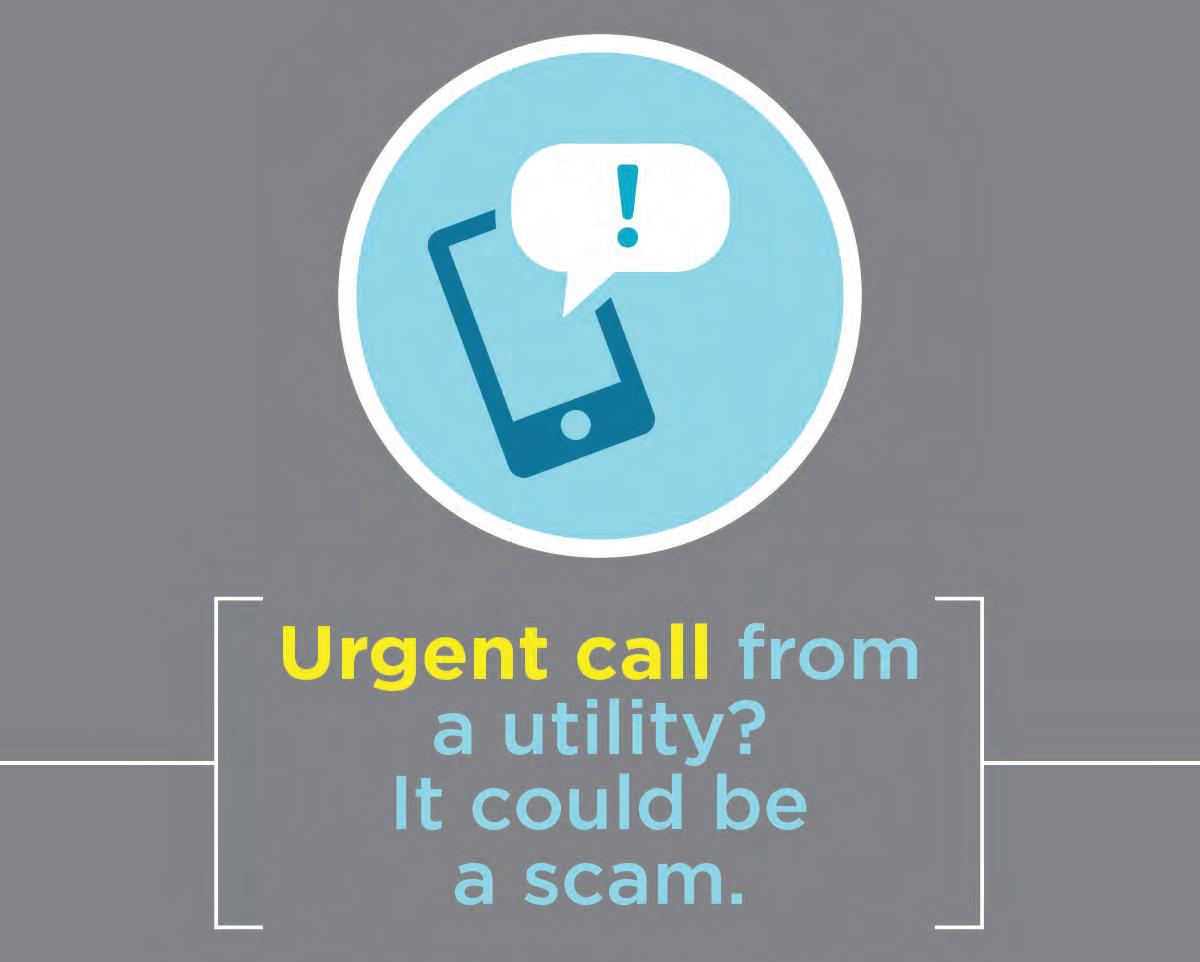
When in doubt, give us a shout. If something sounds suspicious, it probably is. Hang up and call us at 1-800-545-5735.
Our employees will never show up at your door or call to demand payment.
Never give personal information to an unknown caller or visitor. Our representatives have access to the details they need to service your account.
Demands for immediate payment by wire transfer, cryptocurrency, gift cards or cash reload cards should immediately raise red flags.

Typical threats used by scammers are: shutting off your power, legal action or excessive fees added to your account.
1-800-545-5735
www.caec.coop
Where’s the Beef?
Ifirst wrote about the environmentalist movement to eliminate or reduce the consumption of meat in the name of climate change back in 2017. My first article was titled, “Big Mike’s Bean House,” and was centered around a study promoted at the time that advocated substituting beans for meat to reduce carbon emissions. My comments included the thought that Andalusia’s own Big Mike’s Steak House would not be nearly as successful serving beans instead of their signature steaks.
I received notes and letters from readers after the article published asking if I was serious or stating I was just making up things about the climate change movement. I wrote a second article about a year later, “Big Mike’s Bean House – Revisited,” in which I covered additional studies and some employers, like WeWork, that were eliminating meat from company cafeterias and refusing to reimburse employees’ travel expenses for meat at meals. (WeWork is now bankrupt, not due to its dietary restrictions on employees but for extremely poor management decisions about things other than employee diets).
Six years later the climate movement and United Nations (U.N.) are at it again – not that they ever stopped. A U.N. report late last year reported global meat consumption resulted in 7 gigatons of carbon dioxide emissions – about the same as the total global carbon dioxide emissions from natural gas electric generation. The report also states livestock production accounts for 11% to 17% of total global greenhouse gas emissions and about 32% of global methane emissions, a natural by-product of cow digestion, which is 28 times more powerful in trapping heat in the atmosphere than carbon dioxide. The report further states that a cow produces about the same amount of carbon dioxide in a year as a gasoline-powered automobile.
Based upon that report, last November the U.N. supported a declaration passed at COP28, the U.N. 2023 Climate Conference, that states, “We affirm that agriculture and food systems must urgently adapt and transform in order to respond to the imperatives of climate change.” Yes, they are serious.
Efforts to curtail or tax meat or dairy production in some countries have encountered – and continue to encounter – headwinds. Late last year, New Zealand’s ruling government lost its majority due to a revolt by dairy farmers over higher land, livestock and fertilizer taxes. German and French farmers have been blocking traffic in the streets objecting to higher taxes on farm fuels and practices imposed in the name of climate change.

In the U.S., California regulations require dairy farmers to reduce methane emissions by 40% of 2013 levels by 2030. The regulations will effectively drive California’s dairy farmers out of business. The real goal of the regulations and taxes on livestock and dairy production is to raise costs and reduce supply of meat, just like the regulations being imposed on fossil fuels.
Evidence that the climate party has upped its game was apparent recently in New York. Attorney General Letitia James filed a lawsuit against JBS USA, the world’s largest beef producer, claiming JBS fraudulently misrepresented its carbon emissions by omitting the emissions of its suppliers.
The suit alleges that JBS USA’s claims to be “Net Zero” by 2040 are fraudulent, because JBS USA’s forecasts increasing demand for beef in the coming decades, and it plans to meet that demand with increased beef production. In short, JBS USA’s emission goals are inconsistent with its plan to increase meat production and, therefore, fraudulent. In support of its position to levy a heavy fine on JBS USA, Ms. James states, “Beef has the highest total greenhouse gas emissions of any major food commodity. Livestock production contributes about 32% of anthropogenic methane emissions each year.” The logical conclusion is that JBS is a bad actor that produces meat, increases carbon dioxide and methane emissions, and should be punished.
To be clear, JBS has no requirement to report its greenhouse gas emissions, nor the emissions of any of its suppliers. Also, it is under no mandate to control or reduce greenhouse gas emissions.
The purpose of the lawsuit (which was brought under the same statute under which Ms. James recently received a judgment against Donald Trump in the sum of $455 million for defrauding banks by inflating the value of his collateral) is to enrich the state of New York at the expense of people who eat beef, increase the cost of beef to the public, decrease the supply of beef available to the public, and just maybe, slightly reduce the amount of greenhouse gases released into the atmosphere.
This, like all government regulation, is a serious subject. The climate crowd is relentless in its obsession to increase costs and decrease supply of the two things essential for survival – cheap, reliable energy and the food that sustains us. If they have their way, the lady in the old Wendy’s commercial will be saying “Where’s the Beef? And, also, “Where’s the Heat?”
I hope you have a good month.

44 APRIL 2024 www.alabamaliving.coop | Our Sources Say |
Gary Smith is President and CEO of PowerSouth Energy Cooperative.
Closing Deadlines (in
Miscellaneous
FUNERAL INSURANCE PLANS FOR ANY BUDGET. No Exam, Easy Qualification. Visit finalexpenseassured.com or call (813)352-2587
FREE MATERIALS: SOON CHURCH / GOVERNMENT UNITING, suppressing “RELIGIOUS LIBERTY”, enforcing NATIONAL SUNDAY LAW, Be informed! Need mailing address only. POB 374, Ellijay, GA 30540 –tbsmads@yahoo.com, (888)211-1715
Vacation Rentals
GATLINBURG – DOWNTOWN LUXURY CREEKSIDE CONDO – 2BR / 2BA, sleeps 6 –aubie552@gmail.com, (256)599-5552
PANAMA CITY BEACH CONDO – Owner rental – 2BR / 2BA, wireless internet, just remodeled inside and outside – (502)7777819, larrysusemichel@reagan.com, www. theroneycondo.com


MENTONE, AL LOOKOUT MOUNTAIN COTTAGE
RENTALS – Best brow views, River Front –cottagesofmentone.com, Call or text (504)4818666
MILITARY / SERVICE DISCOUNTS on dozens of rentals. No Booking Fees. (251)333-6500, ALAVHR.com
AFFORDABLE BEACHFRONT & BEACHSIDE VACATION CONDOS – SUGAR BEACH CONDOS in ORANGE BEACH, AL. Rent Direct from Christian Family Owners. Lowest Prices on the Beach – www.gulfshorescondos.com, (251)7522366.
Pet friendly – Save $$$ by booking directly from Verified Owners. ALAVHR.com
GULF SHORES CONDOS – Enjoy direct beach views. Spacious two bedroom two bath and one bedroom 2 bath unit. Rent privately, save agency fees. (256)352-5721, amariewisener@ gmail.com.
OWNERS – Join the fastest growing regional site in Alabama. Low annual fee. Verified Owners, no booking fees or commissions. Alabama Vacation Home Rentals. Locally Owned and Operated. (251)333-6500, ALAVHR.com
GULF SHORES / ORANGE BEACH / FORT MORGAN – Choose from hundreds of beach houses and condos! Verified Owners. No Booking Fees. ALAVHR.com
Education
FREE BIBLE CORRESPONDENCE COURSE –write to P.O. Box 52, Trinity, AL, 35673






Alabama Living APRIL 2024 45 | Classifieds |
our office): June 2024 Issue by April 25
2024 Issue by May 25 August 2024 Issue by June 25
are $1.75 per word with a 10 word minimum and are on a prepaid basis; Telephone numbers, email addresses and websites are considered 1 word each. Ads will not be taken over the phone.
email your ad
call
ask for Heather for pricing.; We accept checks, money orders and all major credit cards. Mail ad submission along with a check or money order made payable to
P.O. Box 244014, Montgomery, AL 36124 – Attn: Classifieds. How To Place a Line Ad in Marketplace Answers to puzzle on Page 28 Recipient’s Name:_____________________ Street: City: Zip: Phone: E-mail: RETURN WITH $12 CHECK PAYABLE TO ALABAMA LIVING MAIL TO: Alabama Living 340 TechnaCenter Drive Montgomery, AL 36117 ONLINE: www.alabamaliving.coop Give a 12-ISSUE gift subscription to for only $1 an issue. 1-800-232-AGRI (2474) • Steel Trusses & Shed Joists • Pole Barn Kits & Components NOW OFFERING! • All Steel (Red Iron) Bldg. Kits 2 Week Delivery or Less On: 20’ x 24’; 24’ x 30’; 30’ x 52’ Other Sizes Available - Longer Leads Apply OVER 50 YRS MFG TRUSSES
July
Ads
You may
to hdutton@areapower.com; or
(800)410-2737
ALABAMA LIVING,
A swing in the woods
When I was growing up, I loved swings. Who didn’t? Kids and swings go together like Clearasil and pimples.
For me, it began on the playground, where I would swing so high that the legs on the metal frame would pull out of the ground. That gave me a kiddie rush that was almost equal to eating a dozen Pixy Stix.
Backyard tire swings were even better. For so many of us who grew up in the south, a tire swing was a big part of our childhood.
We had one. My dad found an old tire, and married it with a length of heavy rope. After looping it over a limb on a perfectly located hickory tree, he tied the ends securely. Soon my sister and I were gliding high - up and back, up and back. So simple. So perfect. With a little effort I could almost touch my feet to the eaves of our house.
And what a bonus it was if there was a swing in the woods. Back then, the woods were magnets for 12-yearolds. Not so much today. Nowadays, all those trees would affect their phone service. But I digress.
My friend Steve had one near his house. It was well worth the 15-minute bike ride to go visit him because we headed to The Swing.
If there was a Heisman Trophy for swings, this one would’ve earned a trip to New York City. To get there, you walked through a path flanked by pine, oak, sweet gum and blackberry briars, until you came to a clearing. Then it stood before you in all its glory. A large pine grew out of a steep incline, and someone with no fear of heights attached a cable to its highest limb. A bicycle tire rim bolted to the opposite

end of the cable served as a handle.
It was huge, scary and magnificent.
Once you gathered your courage, you ran until your feet left the ground, and the swing catapulted you in a semicircle around the tree. You felt like the stone in David’s slingshot as you flew over a sea of privet hedge at the bottom of the cliff. There weren’t enough Pixy Stix in the world to give you this kind of high.

Kids from all over knew about The Swing, but not everyone tried it. It looked dangerous - and it was. Because of the angle of the tree and the slope, you could easily attain heights of 20 feet on your ride, over 30 if you took off fast enough. And you had to deal with centrifugal force when sticking the landing. As a result, some boys wouldn’t take the risk. Being called a chicken was a small price to pay to avoid a trip to the hospital.
I couldn’t resist the lure of The Swing, so I used it regularly. But I always began my takeoff well below the highest starting point. As a result, I didn’t fly as high as I could, but 20 feet was just fine.
Not Steve. He always headed to the top. As a result, he went higher and faster than anyone else. In addition, he added twists and turns that made it look like a gymnastic routine. Steve was sailing through the air like an Olympian, while I was happy if I landed without getting strawberries on my knees and elbows.
Recently I reached out to Steve and asked him if he remembered The Swing. After all, it’s been a while since we played in the woods together. He did. In fact, a few years ago, he went back to its original location, and sadly found an apartment complex where it once stood.
I knew that already. Like Steve, I had also gone back to find The Swing. I may not have become a college gymnast like Steve did, but it was a wonderful part of our childhoods.
Along with Pixy Stix.
46 APRIL 2024 www.alabamaliving.coop | Cup o’ Joe |
Joe Hobby is a standup comedian, a syndicated columnist, and a long-time writer for Jay Leno. He’s a member of Cullman Electric Cooperative and is very happy now that he can use Sprout from his little place on Smith Lake. Contact him at jhobby2000@aol.com.
Illustration by Dennis Auth


August
See Page 36
The Best of Order form on Page 39
Hardy Jackson’s Alabama





recipe theme: Blackberries














 Jimmy Gray VP of Engineering & Operations
Jimmy Gray VP of Engineering & Operations













































 The Department of Archives and History is located across from the State Capitol in downtown Montgomery.
More than 19,000 schoolchildren in grades K-12 visited the Archives in 2023.
The Department of Archives and History is located across from the State Capitol in downtown Montgomery.
More than 19,000 schoolchildren in grades K-12 visited the Archives in 2023.



 This will be the third re-enactment of the Aliceville POW Camp.
PHOTO COURTESY OF ALICEVILLE MUSEUM
The actual march from the Aliceville Train Depot to the POW camp occurred on June 2, 1943.
PHOTO COURTESY ALICEVILLE MUSEUM
This will be the third re-enactment of the Aliceville POW Camp.
PHOTO COURTESY OF ALICEVILLE MUSEUM
The actual march from the Aliceville Train Depot to the POW camp occurred on June 2, 1943.
PHOTO COURTESY ALICEVILLE MUSEUM

















 PHOTO BY JOHN FELSHER
PHOTO BY JOHN FELSHER
























































